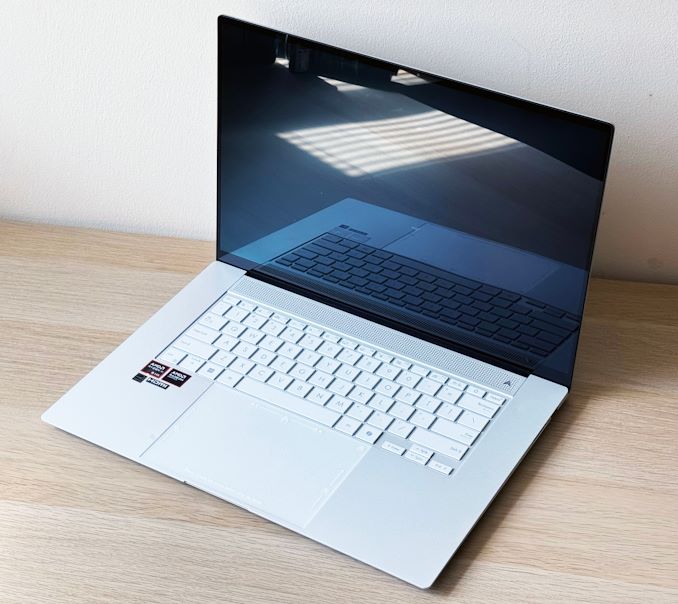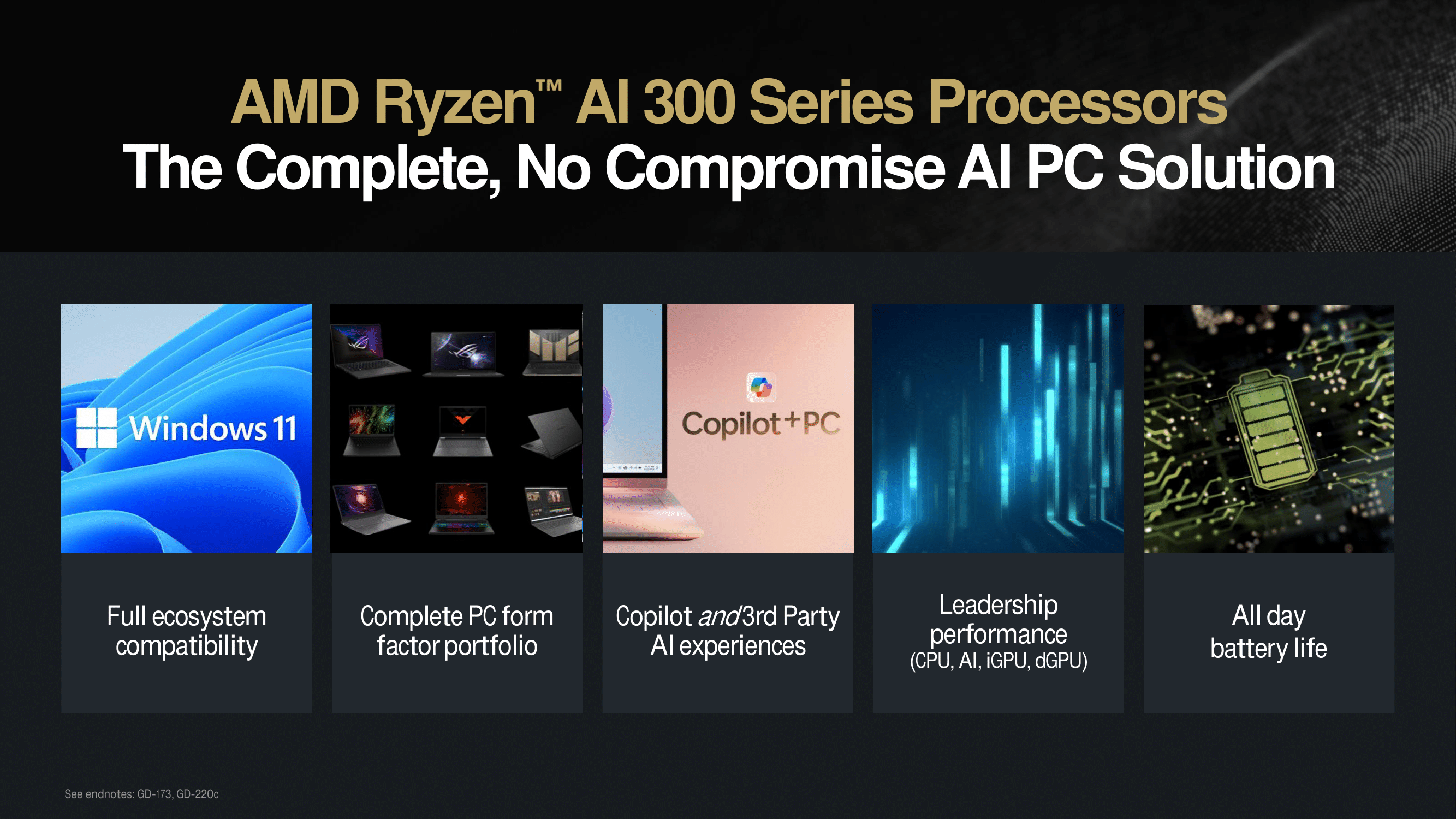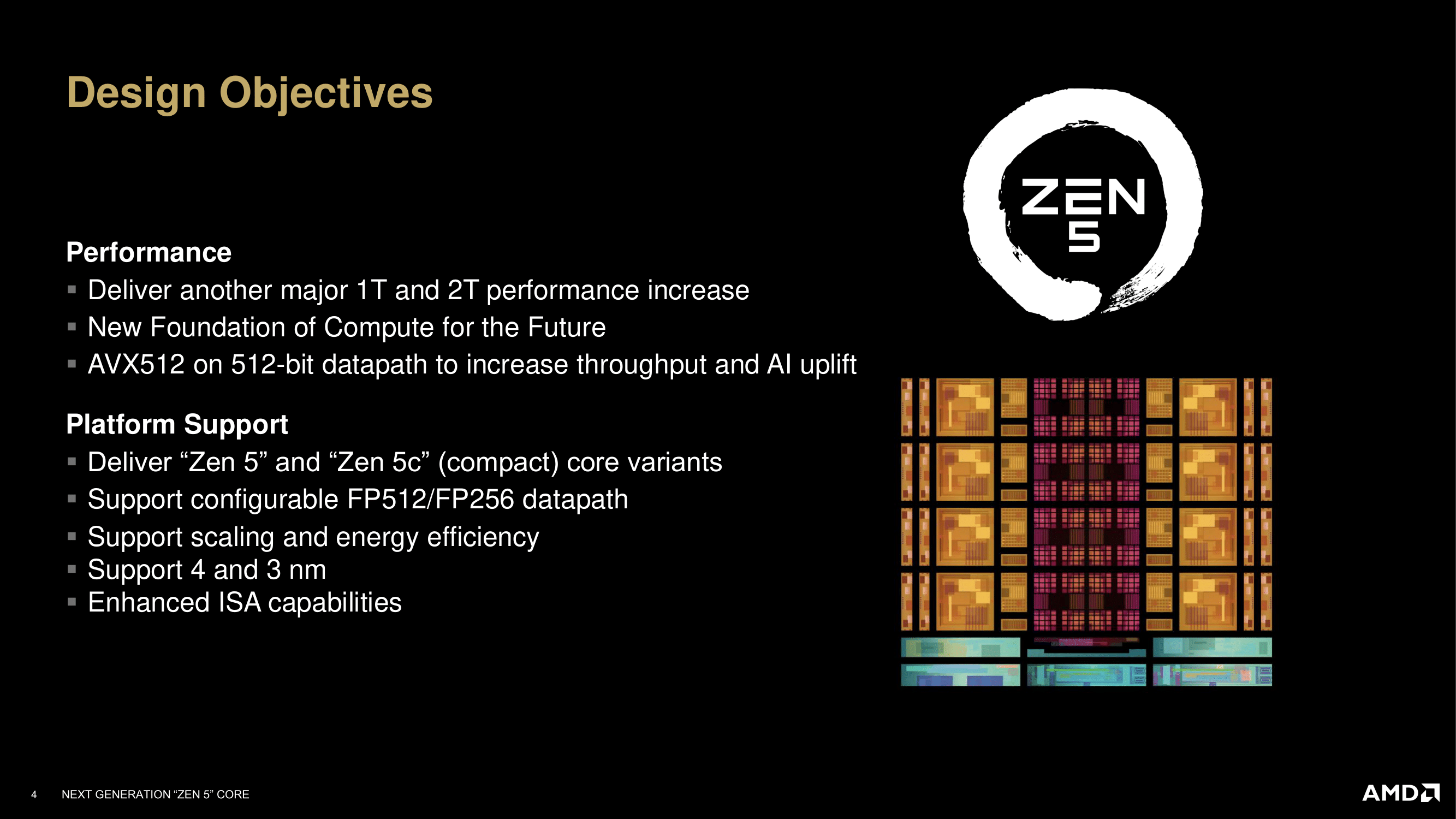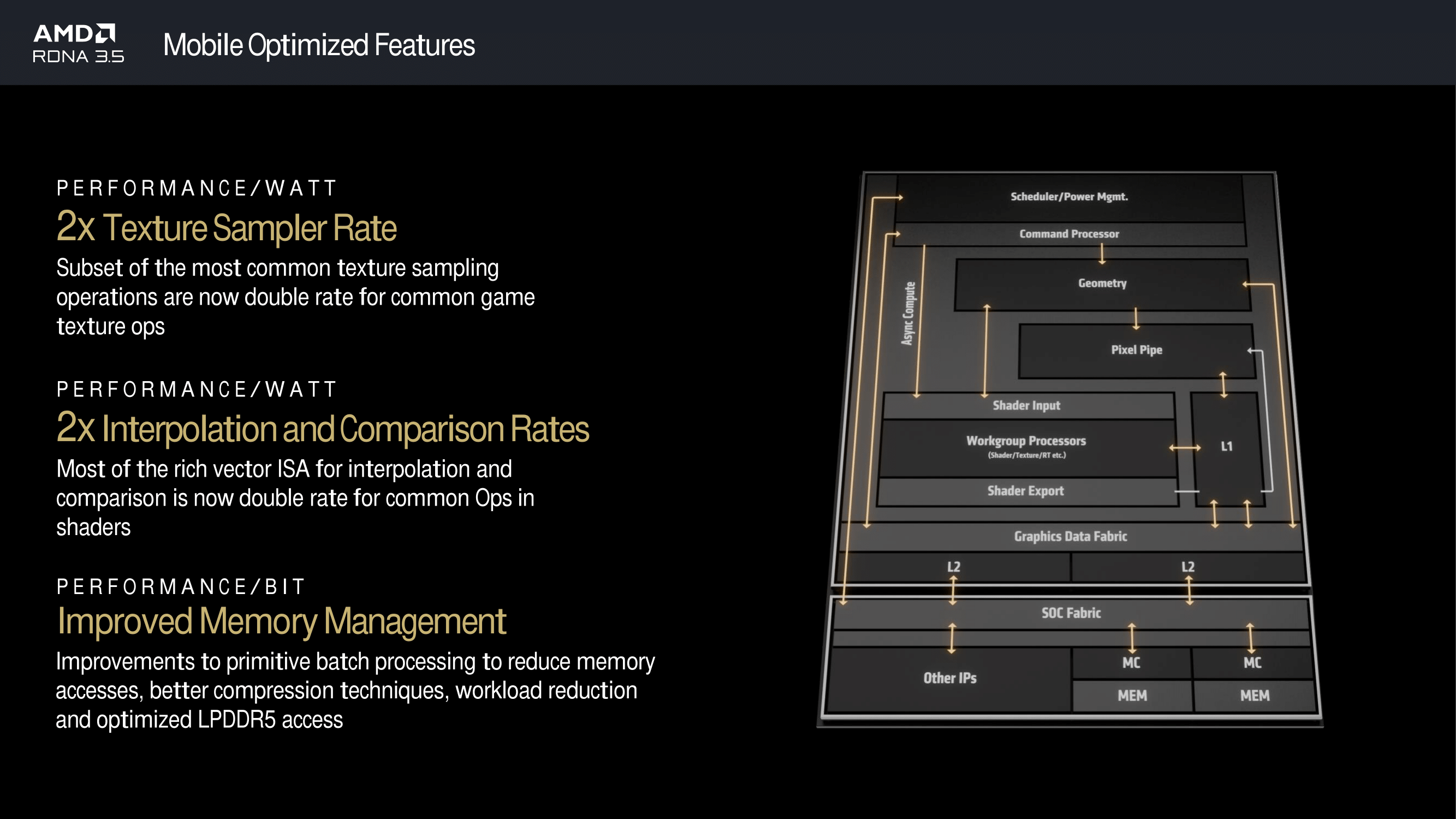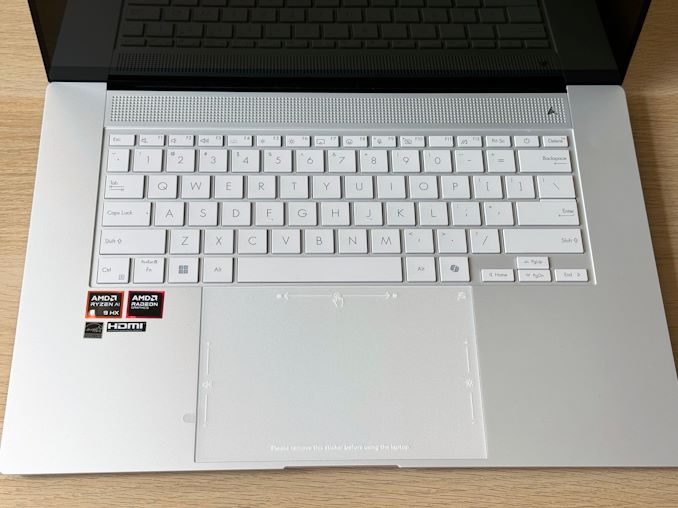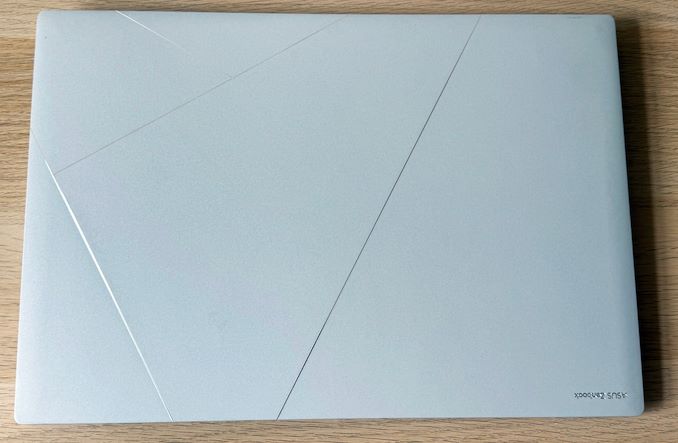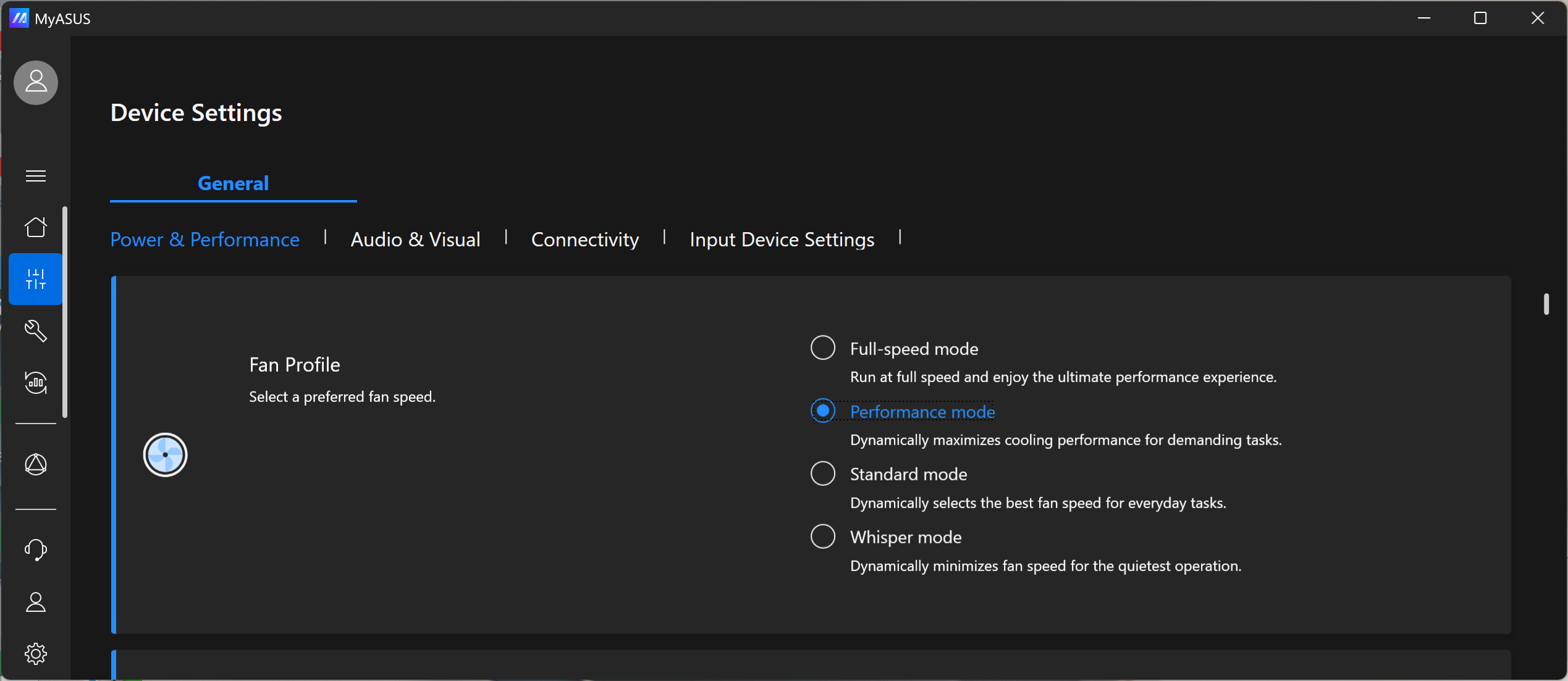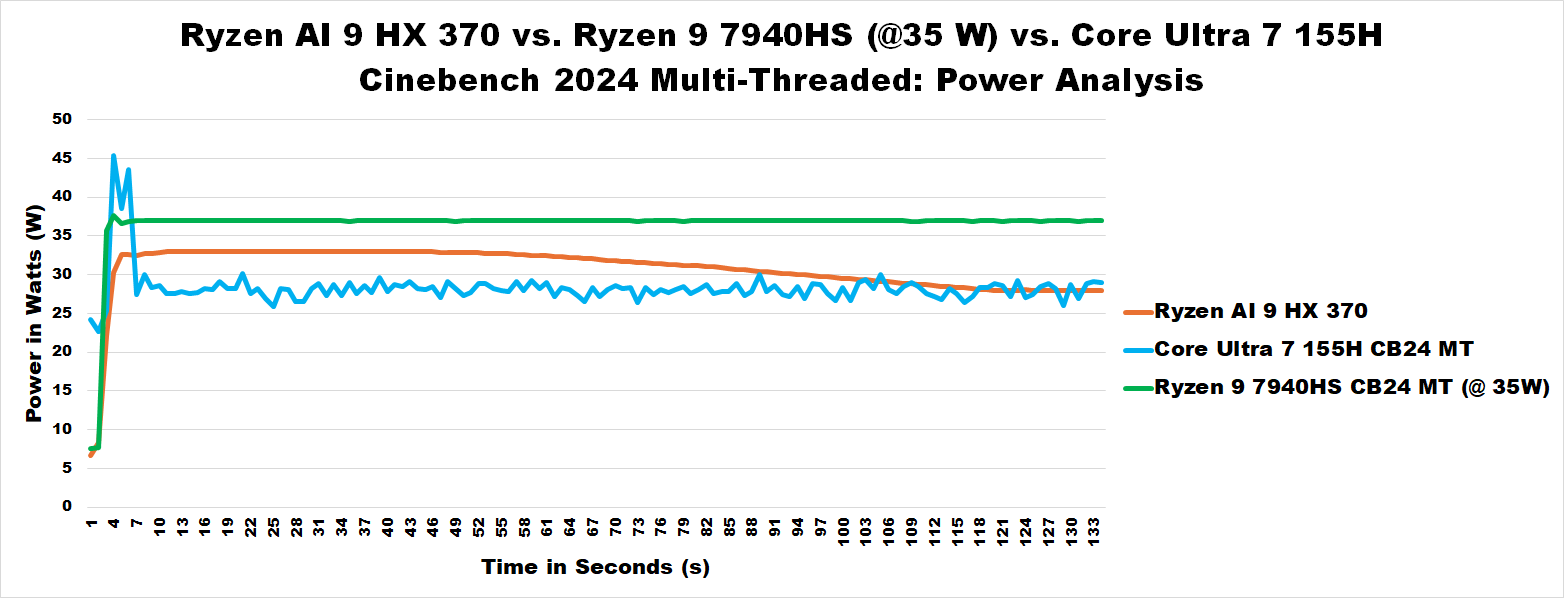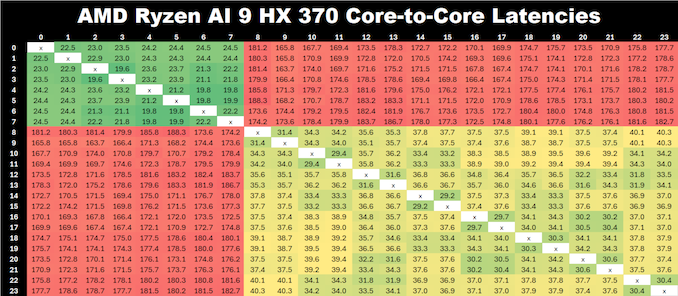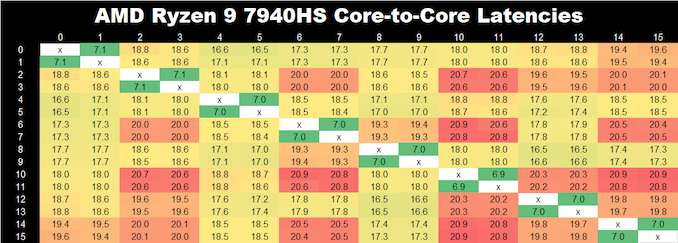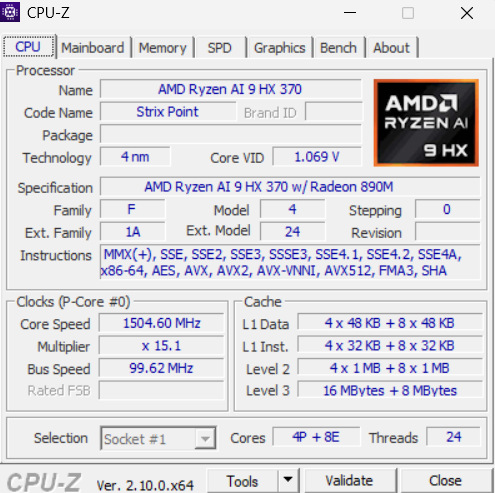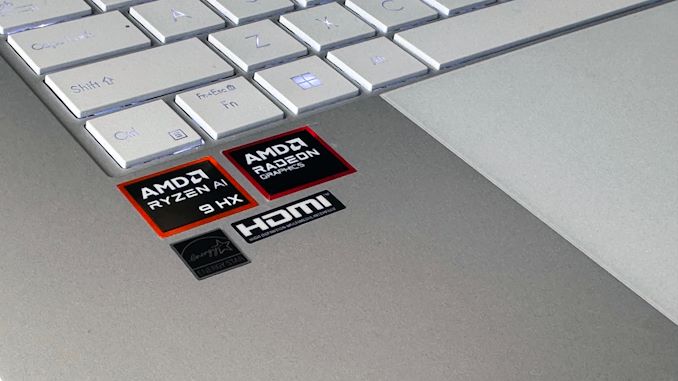
Original Link: https://www.anandtech.com/show/21485/the-amd-ryzen-ai-hx-370-review
The AMD Ryzen AI 9 HX 370 Review: Unleashing Zen 5 and RDNA 3.5 Into Notebooks
by Gavin Bonshor on July 28, 2024 9:00 AM EST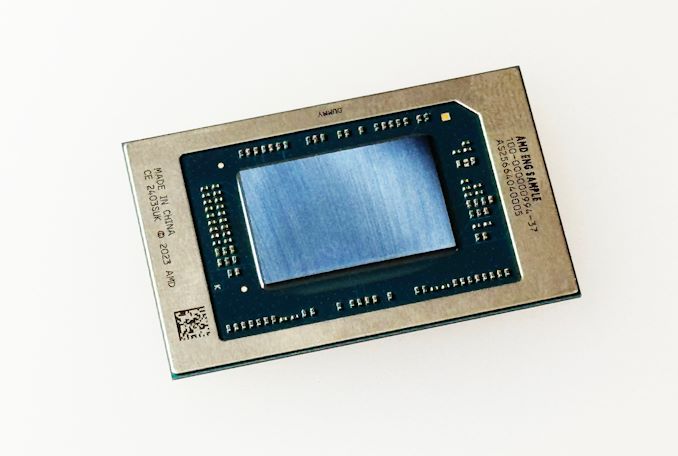
During the opening keynote delivered by AMD CEO Dr. Lisa Su at Computex 2024, AMD finally lifted the lid on their highly-anticipated Zen 5 microarchitecture. The backbone for the next couple of years of everything CPU at AMD, the company unveiled their plans to bring Zen 5 in the consumer market, announcing both their next-generation mobile and desktop products at the same time. With a tight schedule that will see both platforms launch within weeks of each other, today AMD is taking their first step with the launch of the Ryzen AI 300 series – codenamed Strix Point – their new Zen 5-powered mobile SoC.
The latest and greatest from AMD, the Strix Point brings significant architectural improvements across AMD's entire IP portfolio. Headlining the chip, of course, is the company's new Zen 5 CPU microarchitecture, which is taking multiple steps to improve on CPU performance without the benefits of big clockspeed gains. And reflecting the industry's current heavy emphasis on AI performance, Strix Point also includes the latest XDNA 2-based NPU, which boasts up to 50 TOPS of performance. Other improvements include an upgraded integrated graphics processor, with AMD moving to the RDNA 3.5 graphics architecture.
The architectural updates in Strix Point are also seeing AMD opt for a heterogenous CPU design from the very start, incorporating both performance and efficiency cores as a means of offering better overall performance in power-constrained devices. AMD first introduced their compact Zen cores in the middle of the Zen 4 generation, and while they made it into products such as AMD's small-die Phoenix 2 platform, this is the first time AMD's flagship mobile silicon has included them as well. And while this change is going to be transparent from a user perspective, under the hood it represents an important improvement in CPU design. As a result, all Ryzen AI 300 chips are going to include a mix of not only AMD's (mostly) full-fat Zen 5 CPU cores, but also their compact Zen 5c cores, boosting the chips' total CPU core counts and performance in multi-threaded situations.
For today's launch, the AMD Ryzen AI 300 series will consist of just three SKUs: the flagship Ryzen AI 9 HX 375, with 12 CPU cores, as well as the Ryzen AI 9 HX 370 and Ryzen 9 365, with 12 and 10 cores respectively. All three SoCs combine both the regular Zen 5 core with the more compact Zen 5c cores to make up the CPU cluster, and are paired with a powerful Raden 890M/880M GPU, and a XDNA 2-based NPU.
As the successor to the Zen 4-based Phoenix/Hawk Point, the AMD Ryzen AI 300 series is targeting a diverse and active notebook market that has become the largest segment of the PC industry overall. And it is telling that, for the first time in the Zen era, AMD is launching their mobile chips first – if only by days – rather than their typical desktop-first launch. It's both a reflection on how the PC industry has changed over the years, and how AMD has continued to iterate and improve upon its mobile chips; this is as close to mobile-first as the company has ever been.
Getting down to business, for our review of the Ryzen AI 300 series, we are taking a look at ASUS's Zenbook S 16 (2024), a 16-inch laptop that's equipped with AMD's Ryzen AI 9 HX 370. The sightly more modest Ryzen features four Zen 5 CPU cores and 8 Zen 5c CPU cores, as well as AMD's latest RDNA 3.5 Radeon 890M integrated graphics. Overall, the HX 370 has a configurable TDP of between 15 and 54 W, depending on the desired notebook configuration.
Fleshing out the rest of the Zenbook S 16, ASUS has equipped the laptop with a bevy of features and technologies fitting for a flagship Ryzen notebook. The centerpiece of the laptop is a Lumina OLED 16-inch display, with a resolution of up to 2880 x 1800 and a variable 120 Hz refresh rate. Meanwhile, inside the Zenbook S 16 is 32 GB of LPDDR5 memory and a 1 TB PCIe 4.0 NVMe SSD. And while this is a 16-inch class notebook, ASUS has still designed it with an emphasis on portability, leading to the Zenbook S 16 coming in at 1.1 cm thick, and weighting 1.5 kg. That petite design also means ASUS has configured the Ryzen AI 9 HX 370 chip inside rather conservatively: out of the box, the chip runs at a TDP of just 17 Watts.
AMD's Strix Point SoC Architecture: A Quick Recap
Before we dive into our review of the ASUS Zenbook 16 S and AMD's Ryzen 9 AI HX 370 mobile processor, we will quickly recap what's new with the Strix Point SoC and AMD's various processor architectures. Below is a list of our comprehensive and detailed commentary on Zen 5 and the rest of AMD's 2024-2025 mobile platform:
- AMD Announces The Ryzen AI 300 Series For Mobile: Zen 5 With RDNA 3.5, and XDNA2 NPU With 50 TOPS
- The AMD Zen 5 Microarchitecture: Powering Ryzen AI 300 Series For Mobile and Ryzen 9000 for Desktop
Compared to the other PC SoC launches in the past several months, AMD has had a pretty short run-up to today's launch of Strix Point. While Zen 5 has been on AMD's long-term roadmap for years, the company only announced Strix Point and the associated Zen 5 CPU architecture in June, barely two months ago. So this launch has offered a refreshingly short waiting period before we got to see first-hand just what AMD's latest platform can offer.
At the heart of the AMD Ryzen AI 300 series of SoCs (and Ryzen 9000, too) is AMD's latest Zen 5 microarchitecture, which builds upon the success of Zen 4. Zen 5 brings a whole host of improvements to the underlying design compared to its predecessor. The latest chips also come with some minor manufacturing improvements as well, with AMD utilizing TSMC's N4P (4 nm) node to fabricate the Strix Point monodie.
With a mix of full-fat Zen 5 and compact Zen 5c CPU cores, Strix Point has two core complexes (CCXs), one featuring the four Zen 5 cores and the other housing the eight smaller Zen 5c cores. According to AMD, the more compact Zen 5c cores are around 25% smaller than the regular Zen 5 cores, with varying levels of L3 cache.
The AMD Zen 5 microarchitecture is designed to offer higher IPC performance than Zen 4, with AMD claiming an average uplift of 16% over its predecessor for AMD's highest-performance, full-fat Zen 5 core implementation. Zen 5 has been built with performance in mind but still maintains a strong focus on power efficiency, with is critical both in the mobile space and in AMD's lucrative server markets. The Zen 5c cores are specifically geared to offer (nearly) the same instructions per clock (IPC) rate as the full-fat cores, but with a smaller overall footprint on the die.
Still, digging into the fine print you'll find that the Zen 5 cores in Strix Point aren't quite the whole enchilada from a performance perspective. AMD's mobile chips are getting a third core type that is largely identical to the desktop core, but eschews the 512-bit (FP512) SIMD used for highly parallel operations. In lieu of that, both the big (Zen 5) and little (Zen 5c) cores on Strix point get a 256-bit (FP256) SIMD. So there are some small but meaningful differences between the desktop and mobile chips.
AMD's Strix Point has also been given an improved integrated graphics system, with Ryzen AI 300 using the latest RDNA 3.5 architecture. This newest iteration of AMD's venerable RDNA graphics architecture is a relatively minor revision overall versus the RDNA 3 graphics used in Phoenix, lacking any new features, but implementing further optimizations to improve energy efficiency, a critical element for the mobile market.
The net result is that there has been a lot of work going on behind the scenes to optimize the plumbing of the core architecture. Improving memory management is not especially sexy from a feature point of view, for example, but going to memory is an incredibly expensive action in terms of power consumption. So these kinds of optimizations can pay off significantly in GPU and mixed CPU/GPU workloads. Given that laptops are power-constrained environments, those power savings can then be invested in improving overall performance, such as by allowing for higher sustained clockspeeds.
RDNA 3.5 is a bit unique in this respect, as it's the first time an AMD SoC has received an architecturally distinct GPU of its own, rather than just a down-ported version of AMD's discrete GPU architecture. Ultimately, AMD's improvements here will feed back into future architectures, so this isn't any kind of permanent bifurcation, but it's another example of how AMD is dedicating time and resources to better optimize their mobile hardware.
The Ryzen AI 300 Family
Although we are focusing on the AMD Ryzen AI 9 HX 370 in this review, AMD has another two Ryzen AI 300 series (Strix Point) processors. All three Ryzen AI 300 series SoCs amalgamate Zen 5 and Zen 5c cores onto the same die, while two of the chips are branded under AMD's high-performance HX series.
| AMD Ryzen AI 300 Series Mobile Processors (Zen 5/Strix Point) |
|||||||
| AnandTech | Cores | Base Freq |
Turbo Frequency |
L3 Cache |
Graphics | NPU | TDP |
| Ryzen AI 9 HX 375 | 4 x Zen 5 8 x Zen 5c (24 Threads) |
2.0GHz | Zen5: 5.1GHz Zen 5c: 3.3GHz |
24 MB | Radeon 890M 16 CU |
XDNA 2 (55 TOPS) |
15-54W |
| Ryzen AI 9 HX 370 | 4x Zen 5 8x Zen5c (24 Threads) |
2.0GHz | Zen5: 5.1GHz Zen 5c: 3.3GHz |
24 MB | Radeon 890M 16 CU |
XDNA 2 (50 TOPS) |
15-54W |
| Ryzen AI 9 365 | 4x Zen 5 6x Zen5c (20 Threads) |
2.0GHz | Zen 5: 5.0GHz Zen 5c: 3.3 GHz |
24 MB | Radeon 880M 12 CU |
XDNA 2 (50 TOPS) |
15-54W |
What's notable right off the bat here is that AMD has condensed their chip stack significantly versus the Ryzen Mobile 7000/8000 generations. Whereas AMD previously had separate chip lines for the 15-30 Watt (U-series) and 35-54 Watt (HS-series), the Ryzen AI 300 series compresses this down to a single line of chips that can be configured to run anywhere between 15 Watts and 54 Watts – AMD's complete TDP range for mainstream chips. Consequently, the chips can conceivably be placed in anything from a ultrabook up to a desktop replacement laptop. Meanwhile, the default TDP for all of these chips is 28 Watts, which has been an increasingly popular power point for thin & light laptops.
And since we last talked about the AMD Ryzen AI 300 series when we detailed the Zen 5 microarchitecture earlier in the month, AMD has snuck in a third SKU to the Ryzen AI 300 series: the Ryzen AI 9 HX 375. Almost, but not quite identical to the previously-announced Ryzen AI 9 HX 370 SKU, the HX 375 ships with a slightly faster NPU. At 55 TOPS, this NPU is 10% faster than the NPU found in the HX 370 (50 TOPS), and this marks the first time that we've seen any PC vendor (Qualcomm included) offer SKUs with different NPU configurations. It's a small distinction to be sure, but it's also a sign that NPUs are getting powerful enough that there's room for some variation, rather than chip vendors having to ship the fastest configuration they can offer.
NPU matters aside, both the HX 375 and HX 370 feature a 12 CPU core configuration, with 4x Zen 5 and 8x Zen 5c cores. Both core types are capable of SMT, meaning that these chips can have up to 24 CPU threads in flight at once (ed: anyone remember when just 2 threads was a big deal?). And with their wide TDP ranges, they have an equally large clockspeed range, with a base frequency of 2.0GHz and a turbo frequency of up to 5.1 GHz. Both chips are also paired with Strix Point's full integrated graphics configuration, the Radeon 890M with 16 graphics CUs.
The third and final SoC in the stack is the Ryzen AI 9 365, which is a 10 core part and consists of 4x& Zen 5 cores and 6x Zen 5c cores. The Ryzen AI 9 365 can boost up to 5.0 GHz, and gets a slightly cut-down Radeon 880M integrated GPU, which runs with 12 CUs.
Otherwise, all three Ryzen AI 300 chips offer the same cache configuration: 24 MB of L3 cache, which is split as 16 MB on the Zen 5 CCX, and 8 MB on the Zen 5c CCX.
The ASUS Zenbook S 16 (2024) Notebook: A Closer Look
One of the first notebooks announced that would feature AMD's Ryzen AI 300 series was the ASUS Zenbook S 16 (2024), which is a premium ultrathin 16-inch notebook with an impressive feature set. The ASUS Zenbook S 16 (UM5606WA) we received features a striking 'Scandinavian white' colored chassis, which uses ASUS's own material for the build, which they are calling 'Ceraluminum.' ASUS explains it is a high-tech ceramic designed to be robust and light, with the Ceraluminum being an amalgamation of ceramic and aluminum.
The ASUS Zenbook S 16 (UM5606WA) has a 16-inch ASUS Lumina OLED display with a 2880 x 1800 16:10 resolution, a 120 Hz refresh rate, and a maximum brightness of 400 nits, or an HDR peak brightness of 500 nits. Other key specs on the 16-inch Lumina OLED touchscreen display include a 100% DCI-P3 color gamut with HDR True Black 500 certification, and it also comes PANTONE validated for users who want that. ASUS also includes an ASUS Pen 2.0 stylus in the packaging, so users can use the touchscreen without getting it all grubby or covered in fingerprints.
ASUS has done plenty with the keyboard on the Zenbook S 16, which has a 19.5 mm pitch between keys, which means there's 19.5 mm between the center of the key being pressed and the next key to it. ASUS has also opted for an array of commonly used function keys and the Microsoft Copilot+ key, which, when pressed, brings up the Microsoft Copilot+ AI assistant. The keyboard itself features backlighting, which has varying levels of white LEDs behind it; in my opinion, RGB wouldn't suit an elegant chassis such as this. There are also 0.1 mm dish-shaped indentations on each key, while the keys themselves travel 1.1 mm upon a full keypress.
Some of the key hardware inside the ASUS Zenbook S 16 (UM5606WA) in this review includes 32 GB of LPDDR5X-7500 memory in a 2 x 16 GB dual channel configuration. It also has a single 1 TB PCIe 4.0 x4 NVMe SSD, although ASUS says it does support up to 2 TB PCIe 4.0 x4 M.2 SSDs. On the ASUS website, users can select between two different variations. This includes the option to opt for the slightly lower spec Ryzen AI 9 365 processor, which is a 10C/20T chip and comes with AMD's Radeon 880M integrated graphics. Users can also select between 24 GB or 32 GB of LPDDR5X-7500 memory, while users can opt for two different colors; this includes Zumaia Gray or Scandinavian White. Despite the color, it comes with ASUS's Ceraluminum chassis, which is designed to be lightweight and durable on the go.
| AMD Ryzen AI 9 HX 370 Review Platform (Strix Point, Zen 5 + Zen 5c) |
||||||
| ASUS Zenbook S 16 (UM5606WA) As Reviewed |
||||||
| Processor | AMD Ryzen AI 9 HX 370 4xZ5 + 8xZ5c / 24 T 2.0 GHz Base 5.1 GHz Turbo 28 W Base TDP |
|||||
| Memory | 32 GB LPDDR5X - 2x16 | |||||
| GPU | AMD Radeon 890M 16 x RDNA 3.5 Graphics Cores 2.9 GHz Boost |
|||||
| Display | 16" 2880 x 1800 16:10 ASUS Lumina OLED Panel 120 Hz Refresh 0.2 ms Response Up to 400 nits/500nits with HDR 100% DCI-P3 Gamut |
|||||
| Storage | 1 TB PCIe 4.0 NVMe | |||||
| Networking | Wi-Fi 7 Bluetooth 5.4 |
|||||
| Audio | 6 x Speakers Built-in Array Microphone 3.5 mm Audio Jack |
|||||
| Battery | 78 Wh 65 W Watt AC Type-C Adapter |
|||||
| I/O | 2 x USB4 G3 Type-C (Display/PD) 1 x USB 3.2 G2 Type-A 1 x HDMI 2.1 output (TMDS) 1 x 3.5mm Combo Audio Jack SD 4.0 Card Reader |
|||||
| Dimensions | 9.57 x 0.47 x 0.51 inches (353.6 x 240.3 x 12.9 mm) |
|||||
| Weight | 1.50 kg / 3.31 lb | |||||
| Camera | 1080p /w Windows Hello IR | |||||
| Color | Scandinavian White | |||||
| Pricing | $1699 (As configured) | |||||
Along the top bezel in the middle is a full HD (1080p) webcam, which supports Windows Hello (IR), but it also doubles up as an AiSense Camera, which uses AI with Windows Studio Effects and optimizes the scene for more professional-looking video calls. Much of the included software package revolves around encompassing AI, and harnessing what AI on the PC can do.
Touching more on how the Zenbook S 16 feels, it weighs 1.5 kg, or 3.31 lbs, which isn't the lightest ultrathin notebook on the market, but it does look and feel good. Being an ultraportable, it has a very reasonable footprint for a 16-inch notebook, with dimensions of 353.6 x 243.0 x 11.9 mm or 13.92 x 9.57 x 0.47 inches, which makes the Zenbook S 16 a rather sleek notebook. One area to note is the bezels. Surrounding the 16-inch Lumina OLED panel are very thin black bezels, with the top bezel measuring just 0.6 mm and just 0.4mm at the sides, making it appear smaller.
When it comes to I/O, ASUS includes a myriad of options, including two USB 4.0 Gen 3 Type-C ports, both of which support display and power delivery, and a single USB 3.2 G2 Type-A port. There is a single HDMI 2.1 TMDS video output for users looking to connect to a screen, while six Harman Kardon front-facing speakers are designed for immersive sound; there is also a 3.5 combo audio if users wish to go for headphones instead.
As we typically see from premium ASUS notebooks and laptops, they include a comprehensive set of software, with the MyASUS app acting as a sort of central hub for many of the features. This includes selecting between the different fan profiles, including whisper mode, which lowers the power down so the fans can relax, thus creating a quieter environment. Other profiles include the Performance mode, which will ramp the fans up when load is put on the CPU and become quite noisy; it's a trade-off between faster performance and more noise.
Users can also customize the sound profile depending on whether they're watching a movie, listening to music, playing a game, and so forth; this changes the type of audio from the six Harman Kardon speakers, which sound great, especially for notebook speakers. Another piece of software that ASUS includes is StoryCube, which is essentially an AI-driven media hub that uses AI to categorize and sort images across the notebook.
The ASUS Zenbook S 16 UM5606 feels like and looks every bit as premium as any premium notebook comes, with many AI-integrated software features and applications included for users to sink their teeth into. This is not just limited to ASUS's own software but to Microsoft's Copilot+, which, seemingly in software terms, is the star of the show when it comes to what the AI PC seems to look like at present. The real star of the show, however, is the AMD Ryzen AI 9 HX 370 SoC, with the latest Zen 5 cores, as well as compact Zen 5c cores, new integrated graphics featuring AMD's RDNA 3.5 graphics architecture, not to forget the XDNA 2 NPU which is currently the top performing NPU in the mobile space at present.
Pricing for the ASUS Zenbook S 16 UM5606 starts at $1699, which for a bit more is around the same price as the Apple MacBook M3 Pro; there's a lot of competition at the price point. Everyone has their own preference for notebook design, style, and even the chip that powers it, but today is about the Ryzen AI 9 HX 370 with the new Zen 5 microarchitecture. We're putting it up against what came before it, the Ryzen 9 7940HS, and we're also throwing Intel's current Meteor Lake-based Core Ultra 7 155H into the mix too. It's time to see how Zen 5 compares to Zen 4 in the mobile space and how it stacks up against Intel's own 28 W Meteor Lake SoC. Let's find out, shall we?
ASUS Zenbook S 16: Power Consumption & Performance Modes
A big part of any laptop's performance is its TDP – how much energy the chassis can consistently dissipate – meaning that two laptops can have wildly different performance, despite using the same chip, just by virtue of their cooling capabilities. So measuring the peak and sustained power consumed by a laptop is particularly important, both to get an idea of where it falls on the ultrabook-to-DTR spectrum, but also how a design compares to other laptops. Especially with an architecture launch like this one, we need to know if a performance lead comes from architecture and efficiency, or just running a lot of power through a chip.
The AMD Ryzen AI 9 HX 370 has a rather large configurable TDP range overall, with the chip capable of being set to anything between 15 and 54 W. This gives Strix Point a wide berth to fit in everything from ultrabooks to larger gaming notebooks, but it also means that the chip's performance, particularly in heavily multi-threaded and mixed CPU/GPU workloads is going to be defined by its TDP.
Despite its 16-inch frame, In the ASUS Zenbook S 16 is configured rather conservatively. ASUS has taken what's nominally a 28W chip and dialed it down to 17W for it's out-of-the-box experience. Dubbed "Standard Mode" the out-of-the-box experience is a laptop that's highly efficient and highly quiet, but does leave some performance on the table for the sake of acoustics.
ASUS also gives the user quite a bit of latitude to pick performance modes here, with the Zenbook offering 4 different modes altogether. Besides the standard mode, there's the ultra quiet "Whisper mode", the performant "Performance Mode" with a 28W TDP, and the no-holds-barred "Full-speed Mode".
For most of the Zenbook S 16 you'll see today – ours included – you'll find these laptops are running in the 28 Watt Performance Mode. This comes by request of AMD, who is looking to show off what the chip can do at its standard TDP, rather than ASUS's dialed-down TDP. And while we're not beholden to this (or any other) request from AMD, from a pragmatic standpoint it's a lot easier to find 28W laptops than it is 17W laptops. So for our first round of testing, we have dialed up our laptop to its 28W mode.

In our peak power test, the Ryzen AI 9 HX 370 ramped up and peaked at 33 W. We typically see a higher peak power value than the TDP before things settle down during an intensive workload, although the Intel Core Ultra 7 155H within the ASUS Zenbook 14 OLED did manage to peak at 64 W for a very brief moment, which is way out of spec.
Looking at the power of the Ryzen AI 9 HX 370 when using Maxon's latest Cinebench 2024 (multi-threaded test) benchmark, which is quite an intensive rendering workload, we can see how it compares to the Ryzen 9 7940HS when dialed down to 35W, as well as the Intel Core Ultra 7 155H which is running at 28W within the ASUS Zenbook 14 OLED. Aside from the very large spike up to 45W on the Core Ultra 7 155H, we see a pretty consistent level of power usage from the CPU package (the cores).
Focusing on the Ryzen AI 9 HX 370, we can see it quickly ramped up and achieved a very consistent load level, bouncing between 32 and 33 W throughout the Cinebench 2024 MT benchmark loop. As the benchmarking loop carried on, power consumption slowly dropped to a steady-state TDP of 28W, matching the configured TDP of the laptop. The slow and gradual drop in power towards the end was very smooth. The same can be said about the Ryzen 9 7940HS. In contrast, the Intel Core Ultra 7 155H produces some slightly noisier data, bouncing around between 26.5 W and 29 W throughout the test.
Core-to-Core Latency: Zen 5 Strix Point Vs. Zen 4 Phoenix Point
As the core count of modern CPUs is growing, we are reaching a time when the time to access each core from a different core is no longer a constant. Even before the advent of heterogeneous SoC designs, processors built on large rings or meshes can have different latencies to access the nearest core compared to the furthest core. This rings true especially in multi-socket server environments.
But modern CPUs, even desktop and consumer CPUs, can have variable access latency to get to another core. For example, in the first generation Threadripper CPUs, we had four chips on the package, each with 8 threads, and each with a different core-to-core latency depending on if it was on-die or off-die. This gets more complex with products like Lakefield, which has two different communication buses depending on which core is talking to which.
If you are a regular reader of AnandTech’s CPU reviews, you will recognize our Core-to-Core latency test. It’s a great way to show exactly how groups of cores are laid out on the silicon. This is a custom in-house test, and we know there are competing tests out there, but we feel ours is the most accurate to how quick an access between two cores can happen.
In this core-to-core latency analysis, we'll be comparing the AMD Ryzen AI 9 HX 370, which uses a combination of full-size Zen 5 cores with the more compact Zen 5c cores, directly to its predecessor, the Zen 4 Ryzen 9 7940HS.
Looking at the core-to-core latencies of the AMD Ryzen AI 9 HX 370, we can see that AMD has changed the core structure from previous generations. AMD, for Strix Point, has restructured the core architecture compared to what we've seen on Zen 4 (Phoenix Point), with the full-sized Zen 5 cores and the smaller Zen 5 cores being placed on separate core complexes. This change in the fundamental architecture of previous generations does impact latency regarding the efficiency of inter-core communication.
Although on a separate CCX from the full-sized Zen 5 cores, the compact Zen 5c cores are present on the same die. Observing the inter-core latencies of the full-sized Zen 5 cores, which are shown as cores 0-7 in the above chart, range from 19.6 ns to 24.5 ns, which shows that the Zen 5 cores are communicating efficiently with each other on the core complex.
Communicating outside of the Zen 5 cluster and contacting the Zen 5c cores, the latency inherently increases to between 163.7 and 188.7 ns, which shows a significant latency penalty and much more than we anticipated. This can have a negative impact on workloads that potentially require frequent cross-cluster data exchanges. The Zen 5c cluster itself within the complex has higher latencies per each L1 access point, which shows there's an overhead within the pathway when communicating cross-cluster.
Having multiple clusters of cores on the same die does pose significant penalties across the longer pathways, especially when hopping out of the cluster to contact cores on the other. The latencies vary massively depending on the length of the pathway. Each cluster (Zen 5 + Zen 5c) operates efficiently on its own and poses an added level of complexity, but it is more of a trade-off when using multiple core clusters on a single package.
SPEC CPU 2017 Performance
SPEC CPU 2017 is a series of standardized tests used to probe the overall performance between different systems, different architectures, different microarchitectures, and setups. The code has to be compiled, and then the results can be submitted to an online database for comparison. It covers a range of integer and floating point workloads, and can be very optimized for each CPU, so it is important to check how the benchmarks are being compiled and run.
We run the tests in a harness built through Windows Subsystem for Linux, developed by Andrei Frumusanu. WSL has some odd quirks, with one test not running due to a WSL fixed stack size, but for like-for-like testing it is good enough. Because our scores aren’t official submissions, as per SPEC guidelines we have to declare them as internal estimates on our part.
For compilers, we use LLVM both for C/C++ and Fortan tests, and for Fortran we’re using the Flang compiler. The rationale of using LLVM over GCC is better cross-platform comparisons to platforms that have only have LLVM support and future articles where we’ll investigate this aspect more. We’re not considering closed-source compilers such as MSVC or ICC.
clang version 10.0.0
clang version 7.0.1 (ssh://[email protected]/flang-compiler/flang-driver.git
24bd54da5c41af04838bbe7b68f830840d47fc03)
-Ofast -fomit-frame-pointer
-march=x86-64
-mtune=core-avx2
-mfma -mavx -mavx2
Our compiler flags are straightforward, with basic –Ofast and relevant ISA switches to allow for AVX2 instructions.
To note, the requirements for the SPEC license state that any benchmark results from SPEC have to be labeled ‘estimated’ until they are verified on the SPEC website as a meaningful representation of the expected performance. This is most often done by the big companies and OEMs to showcase performance to customers, however is quite over the top for what we do as reviewers.
It should also be noted that, while we've done what we can to keep testing apples-to-apples across our laptops, there are limits to how much these devices can be adjusted – and we're dealing with what are still fundamentally TDP-limited devices given their slim form factors. So these results are not strictly iso-power.
Of note, while the Intel Core Ultra 7 and Ryzen AI 9 are dialed in to a TDP of roughly 28 Watts, AMD's Zen 4/Phoenix testing vehicle, Razer's Blade 14 laptop, cannot be turned down any further than 35 Watts. So last-gen Zen has an edge in TDPs. Meanwhile, Apple M3 results come from a 2023 MacBook Pro 14-Inch, which is comparable in size and cooling capabilities to the 28W laptops, but is not strictly the same either. (AMD encourages reviewers to use the MacBook Air instead, but comparing a passively-cooled laptop to an actively-cooled run running in Performance mode hardly seems sporting)
Single-Threaded (Rate-1) Results
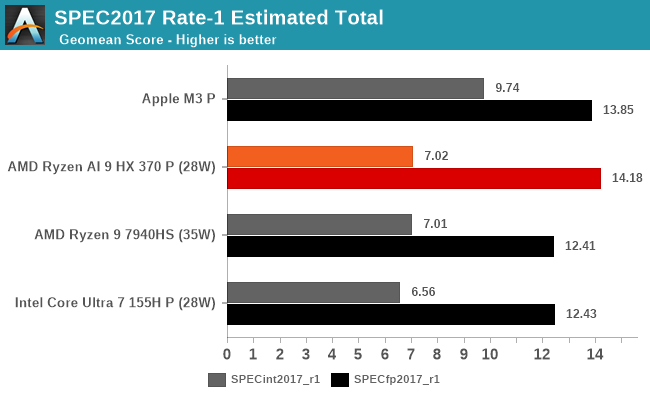
As SPEC CPU's many different sub-tests can be a bit hard to digest all at once, let's start with the geomean score of the whole suite, for a high-level look at where performance stands.
In its highest performance configuration, AMD is touting a 16% average IPC uplift for the Zen 5 architecture. But this is for the full-fat configuration with 512-bit wide SIMDs for single-cycle AVX-512 support. What Strix Point offers is a bit less, with just a 256-bit wide SIMD requiring execution over multiple cycles. The architecture still benefits from the AVX-512 instructions, but it doesn't gain the data throughput benefits. So mobile Zen 5 already starts off with a smaller potential performance uplift. Coupled with that, Ryzen AI 9 HX 370 has a peak clockspeed of 5.1GHz, versus 5.2GHz for the Ryzen 9 7940HS, so there is a slight regression here in terms of clockspeeds for the mobile parts.
All of which is to say, that these trade-offs erode some of the single-threaded performance gains the Zen 5 architecture otherwise offers, and SPEC CPU 2017's integer benchmarks seem rather unfazed. Here the HX 370 only barely edges out the 7940HS by the very slightest amount – 0.01 points – and this is not a workload where the chips' TDP differences should matter. So our first test does not find significant gains for AMD's new architecture. Still, we're treating mobile as more of a preview of things than the final word, as the desktop release should be far more enlightening thanks to the ability to better ensure platform parity, as well as throwing TDP concerns out the window altogether.
But for what mobile Zen 5 doesn't bring to the table in terms of integer performance, it looks far better in terms of floating point performance. At a geomean score of 14.18, the HX 370 is 14% ahead of the 7940HS, which is much closer to AMD's IPC claims. Among Zen 5's tweaks was allowing for a larger number of FP instructions to be in flight, and that certainly seems to be in effect here.
In fact, in floating point the HX 370 is the fastest of our mobile chips; with Zen 5, AMD moves from beating Intel in integer and tying in floating point to beating Intel all-around. We'll still see some sub-tests where the Core Ultra pulls ahead, but overall Zen 5 is a stronger architecture and it shows. Even Apple's M3 SoC gets edged out here in terms of floating point performance, which, given that Apple is on a newer process node (TSMC N3B), is no small feat. Still, there is a sizable deficit in integer performance versus the M3, so while AMD has narrowed the gap with Apple overall, they haven't closed it with the Ryzan AI 300 series.
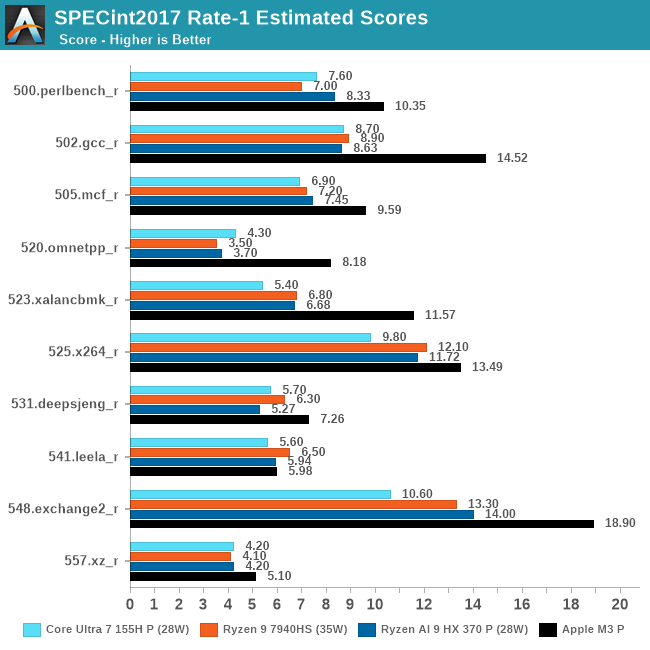
Across the complete set of integer benchmarks, the HX 370 does more often than not pull ahead of the 7940HS. However we also see more than one instance of the newer chip falling behind – 531.deepsjeng in particular stands out, where HX 370 is the slowest chip. I'm a bit curious if we're seeing some memory interplay here – the 7940HS system had DDR5, versus LPDDR5X on the HX 370 – but there's not quite enough information to draw a conclusion.
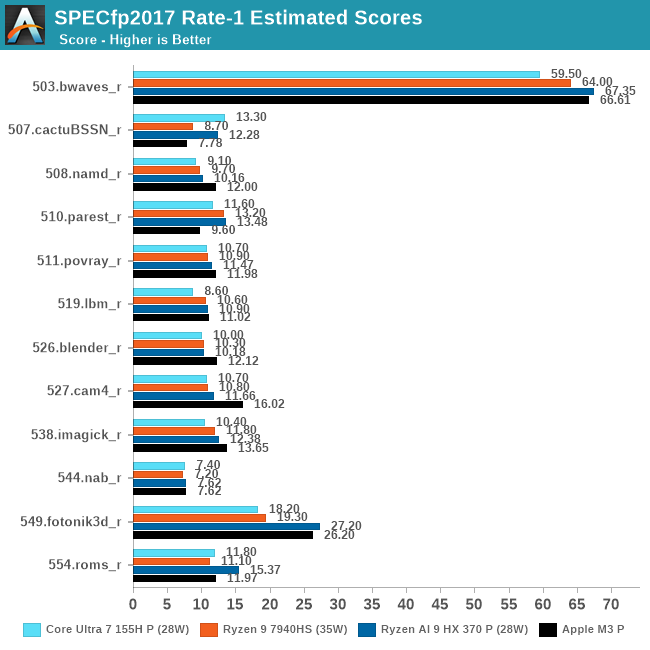
As outlined in the geomean scores, floating point tests look more favorable to AMD overall. There are no performance regressions here; the HX 370 at least marginally improves on its predecessor in every single test. And in a few, like 549.fotonik3d, it leaps ahead by 41%. AMD even clears the M3 here, which was well out of reach with Zen 4. Overall this makes Zen 5 initially look very promising for floating point workloads.
Multi-threaded (Rate-N) Results
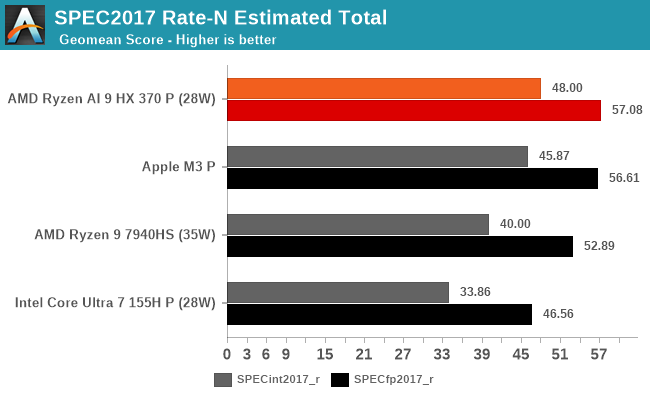
Shifting gears to multi-threaded performance, we have the SPEC CPU 2017 rate-N tests, where we run (nearly) as many copies of SPEC CPU 2017 as there are threads. Rate-N testing doesn't test core-to-core communication much, but it does push throughput hard, as upwards of 24 threads are vying for cache, memory, and other resources.
Adding a wrinkle to all of this, HX 370 (Strix Point) is the first time that AMD has put their compact Zen cores in a high-end mobile processor. This performance/efficiency core split is by no means new in the industry overall (both the M3 and Core Ultra 7 do something similar), but it's still a big shift for AMD's flagship mobile chips, as achieving peak multithreaded performance is now not about saturating 8 performance cores, but saturating 4 performance cores and then another 8 efficiency cores on top of that.
With Rate-N being TDP-limited in a laptop, this is less a test of architectural throughput than it is overall efficiency, and not surprisingly, it paints a very different picture from rate-1 results – and one that's very favorable to AMD. Overall, the HX 370 is the top chip, not only meaningfully improving on the 7940HS in both integer and FP workloads, but even edging out Apple's M3. The 4 additional efficiency (Zen5c) cores is likely playing a major role here versus Apple, but given that all of these devices are similarly power constrained, AMD is still getting more work done overall despite those conditions. In SPEC CPU 2017, at least, it looks like a good trade-off.
Interestingly, despite AMD's flat integer performance in ST results, the HX 370 sees its biggest gains under MT integer workloads, improving on the 7940HS by 20%. Even with their lower peak clockspeed, those additional Zen5c cores are doing a lot to boost performance here. Meanwhile, MT floating point performance is just 8%, likely coming as a result of TDP limitations. While we don't have a detailed power breakdown available on these mobile platforms, if AMD's FP performance gains come at a cost of higher power consumption per core, then that would in turn bottleneck performance under these heavy MT workloads.
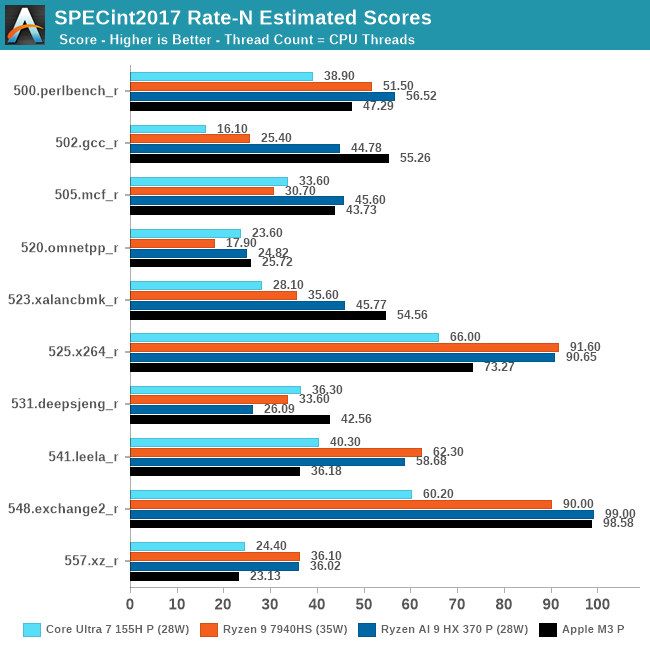
Breaking down our results to the individual benchmarks, the HX 370 significantly improves upon its predecessor in several tests, including 502.gcc, 505.mcf, and 520.omnetpp. Especially compared to the more anemic gains in these benchmarks in single-threaded mode, these benchmarks show the performance advantage of a larger number of efficiency cores versus the 7940HS's flat 8 performance core configuration. Still, these are some regressions; 531.deepsjeng performance still drops here, and the extra cores aren't doing anything to help out 525.x264 performance.

Under multi-threaded floating point performance, there are again some big gains, such as in 526.blender and 519.lbm, as well as smaller gains in the likes of 538.imagick. Meanwhile the most surprising result comes in 503.bwaves, which sees a significant performance regression versus the 7940HS. We've run this test several times and it doesn't seem to be a fluke; bwaves just doesn't seem to like those compact Zen 5 cores very much. Which makes these results a great showcase for the trade-offs involved in using a heterogeneous core selection – adding weaker cores can help a lot of workloads, but there will always be some workloads that just want as many performance cores as they can get their hands on.
System & Storage Performance
The next section of our updated notebook test suite includes web and office-based tests. Our updated notebook suite runs in parallel with our current CPU test suite for 2024. It also allows us to blend mobile chips tested with desktop chips, mainly to see how efficiency and performance levels stack up for each generation we try.
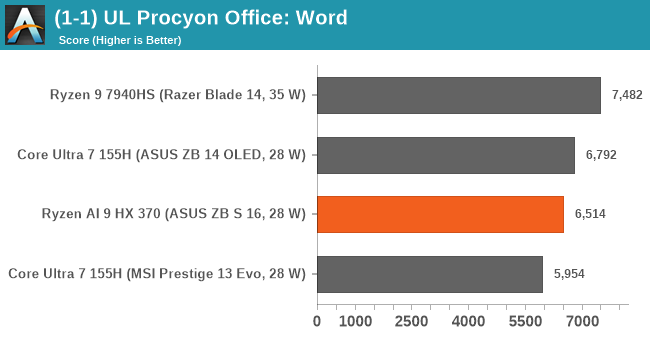
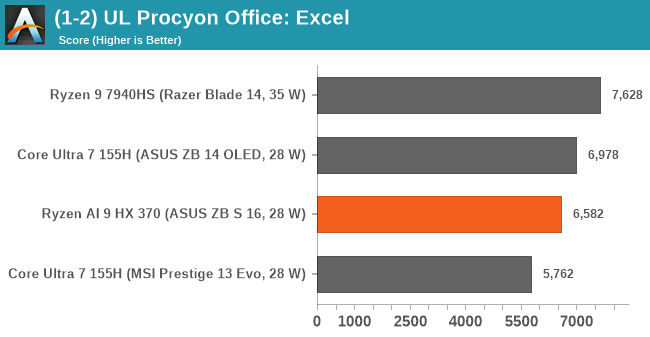
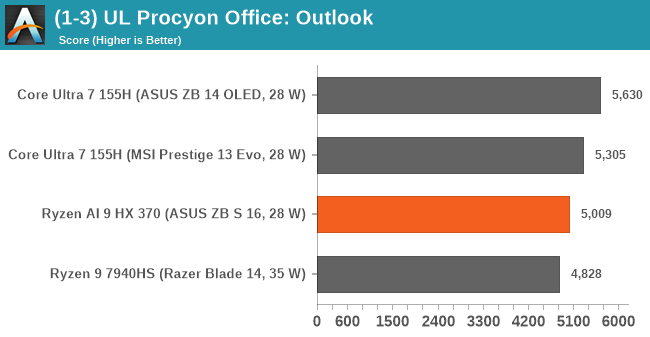
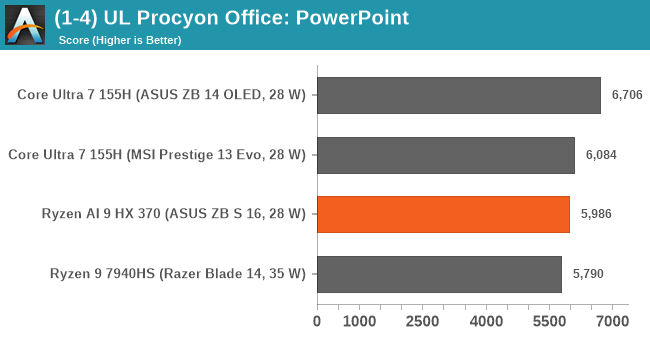
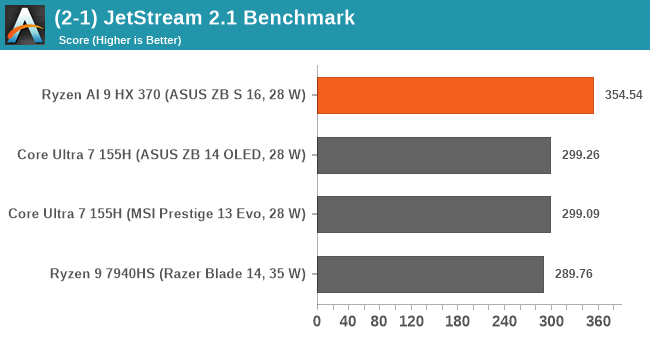
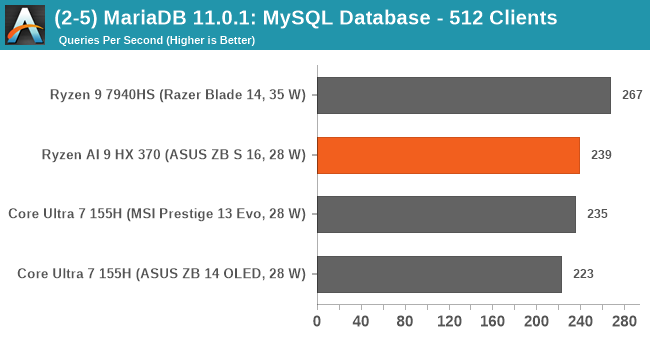
Looking at the Ryzen AI 9 HX 370's performance in our web and office-based tests, we see middle-of-the-road performance compared to the other mobile chips on the test. One example of where we see the Ryzen AI 9 HX 370 comfortably come out on top is in the JetStream 2.1 web-based benchmark, which looks at a wide variety of JavaScript and WebAssembly workloads. Things overall aren't really much different between the chips in terms of performance in this section of the suite.
Storage
When it comes to ultrathin notebooks, finding the right balance between storage performance and having the means to be able to keep it cool is quite the trade-off. There's more to storage performance than just putting in the fastest drive you can; other variables include the interface used, the quality of the controller, and the overall drive. The ASUS Zenbook S 16 (UM5606WA) includes a single 1 TB drive, which, in our sample, is made by Micron. ASUS uses the Micron 2400 MTFDKBA1T0QFM, a QLC drive with a PCIe 4.0 x4 interface controller.
Looking at read and write performance using CrystalDiskMark 8.0.5, we see sequential read speeds of just over 5000 MB/s, with write speeds around the 2750 MB/s mark. It's a decent level of throughput for an ultrathin notebook, but it's not setting any records. The Micron drive used here is an budget design – DRAMless with QLC NAND – and for better or worse, is pretty typical fare for OEM laptops.
When judging and measuring storage performance, it comes down to real-world performance and ensuring optimal cooling, especially on these fast NVMe drives, which can run very hot and thermally throttle, reducing performance.
Encoding Performance
One of the interesting elements of modern processors is encoding performance. This covers two main areas: encryption/decryption for secure data transfer and video transcoding from one video format to another.
In the encrypt/decrypt scenario, how data is transferred and by what mechanism is pertinent to on-the-fly encryption of sensitive data—a process that more modern devices are adopting to improve software security.
We've updated our list of encoding benchmarks for our 2024 CPU suite to include some of the most relevant and recent codecs, such as AV1 and HEVC. Not only this, but we have also WebP2 image encoding into the mix to show not only how the latest processors perform with these codecs but also to show discrepancies in performance throughout the different segments.
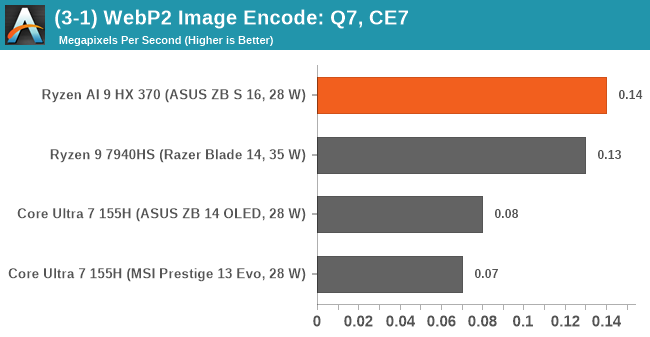

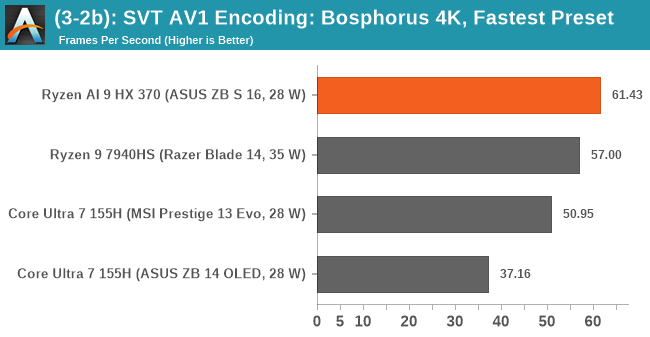
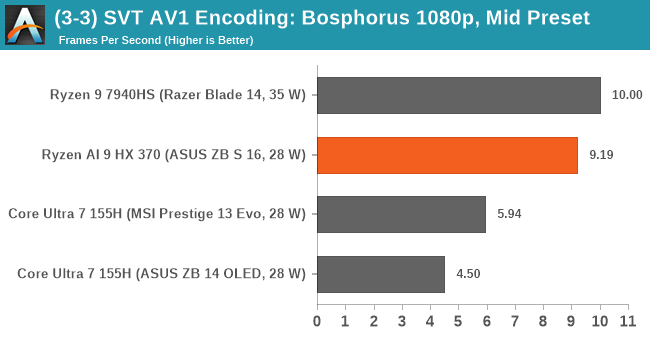
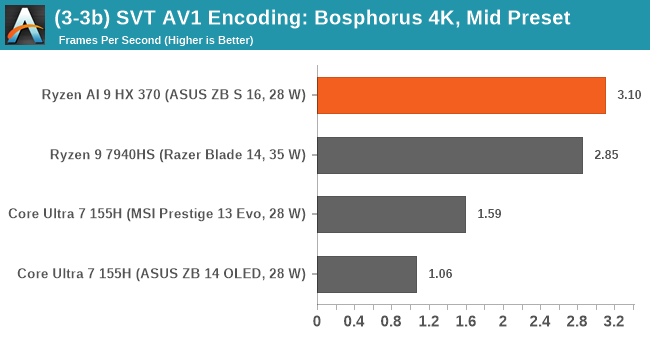
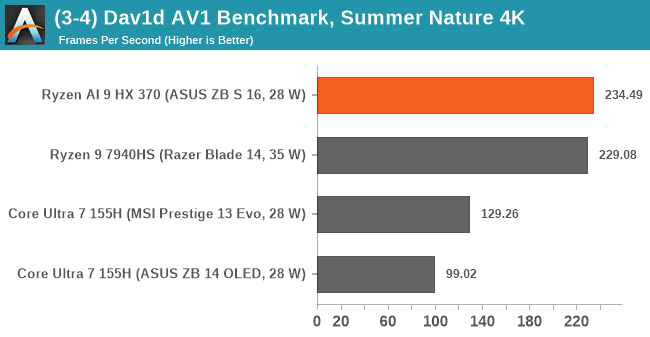
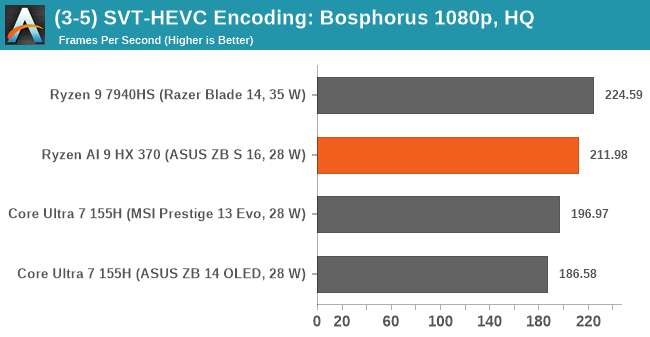
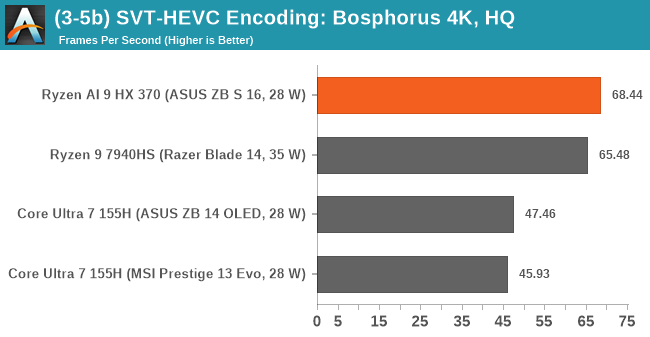
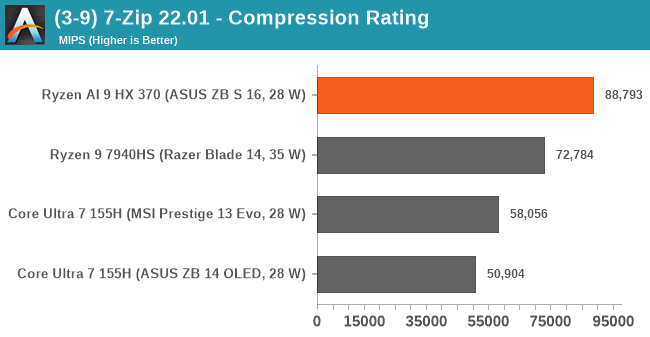

Moving onto the encoding section of our CPU test suite, the Ryzen AI 9 HX 370 performs very well for the most part, including in our AV1 benchmarks at 4K, although it was a battle against the Phoenix Point based Ryzen 9 7940HS. However, the 7940HS had slightly more power available to it (35 W vs. 28 W), which shows that the difference between Zen 5/Zen 5c and Zen 4 cores didn't prove too different regarding our encoding tests.
Rendering & Simulation Performance
Rendering tests, compared to others, are often a little more simple to digest and automate. All the tests put out some sort of score or time, usually in an obtainable way that makes it fairly easy to extract. These tests are some of the most strenuous in our list, due to the highly threaded nature of rendering and ray-tracing, and can draw a lot of power.
If a system is not properly configured to deal with the processor's thermal requirements, the rendering benchmarks are where it would show most easily as the frequency drops over a sustained period of time. Most benchmarks, in this case, are re-run several times, and the key to this is having an appropriate idle/wait time between benchmarks to allow temperatures to normalize from the last test.
Also in this section is our simulation based tests, including our typical gaming simulation benchmarks which consists of our Dwarf Fortress and Factorio benchmarks.
Rendering
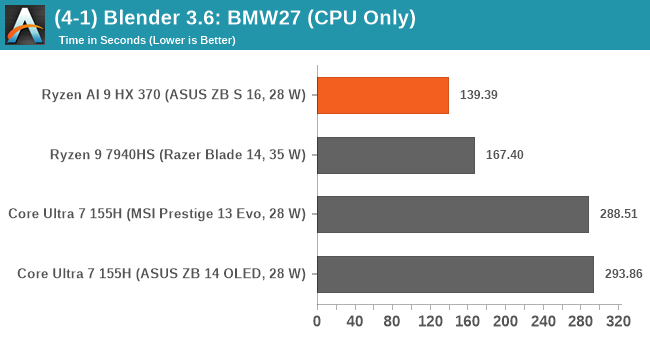
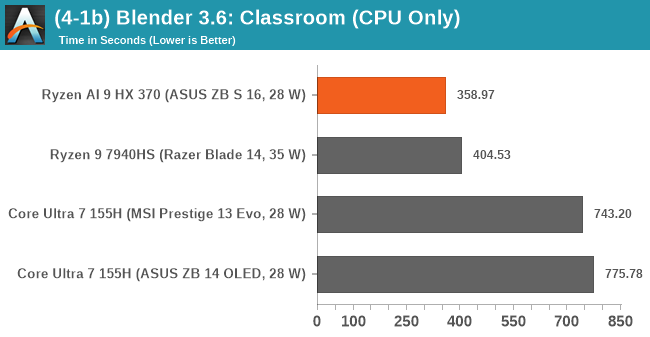
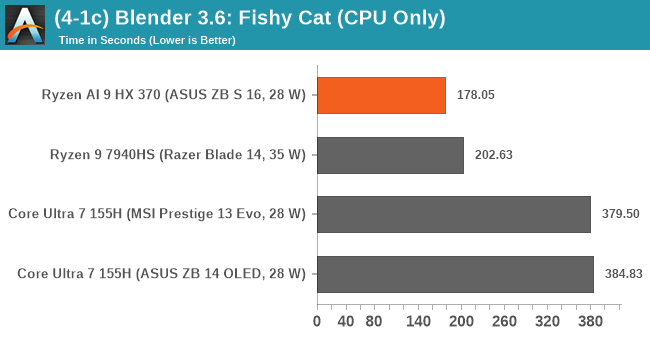
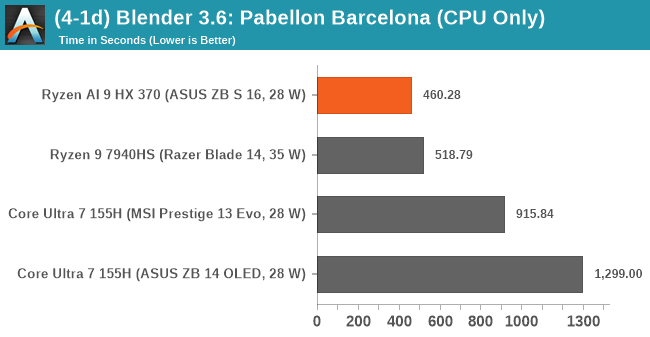
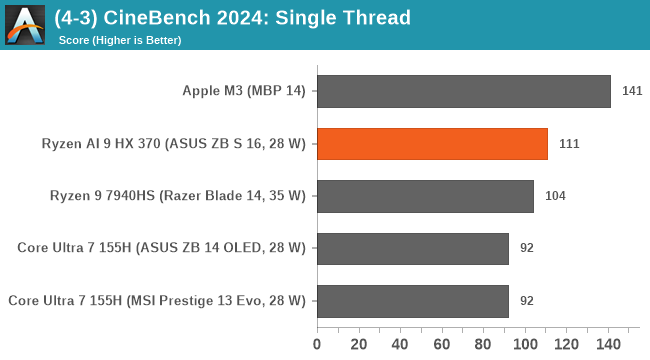
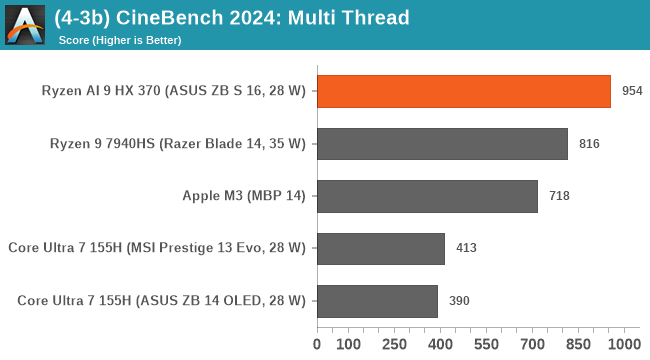
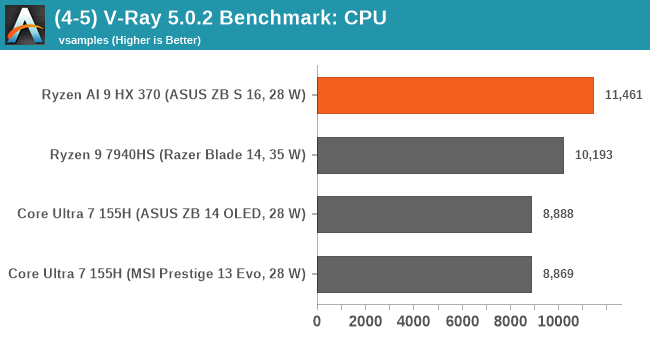
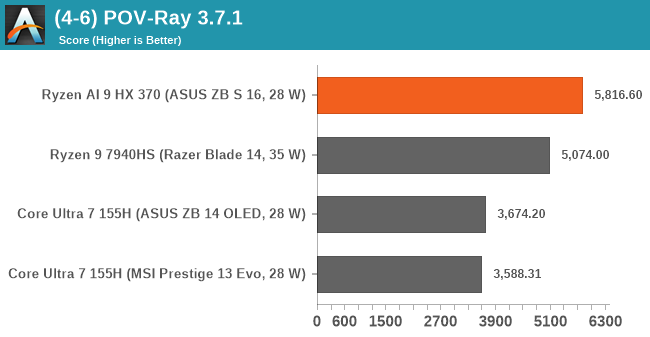
Starting off with the rendering section, the AMD Ryzen AI 9 HX 370 has finally come to the forefront with the Zen 5 and Zen 5c cores, with consistent wins in all of the multi-threaded rendering benchmarks we ran. In the Cinebench 2024 benchmark using the single-threaded test, we can see the Ryzen AI 9 HX 370 is ahead of its predecessor, the Ryzen 9 7940HS, by just under 7%; this is primarily down to the uplift to IPC performance, among other improvements from going to Zen 5 from Zen 4.
In the multi-threaded test in Cinebench 2024, the latest Strix Point with Zen 5 also shows dominance, beating the Ryzen 9 7940HS by just under 17%. It would be interesting to see a direct comparison in core count, as the Ryzen AI 9 HX 370 has four more cores, albeit four of them are full-fat Zen 5 cores, with eight compact Zen 5c cores, too. It's also worth noting that despite the Ryzen AI 9 HX 370 and the Intel Core Ultra 7 155H both having a 28 W TDP, there's no contest regarding raw firepower in rendering workloads.
Simulation
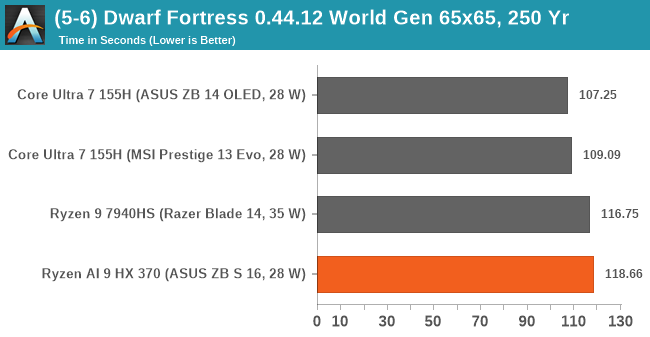
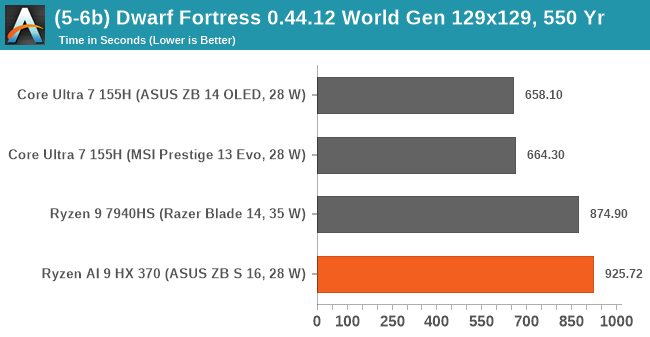
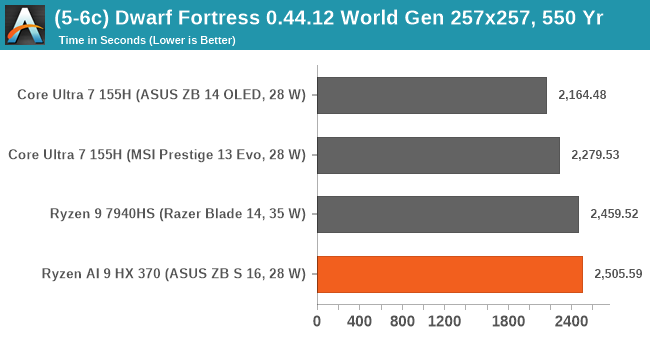
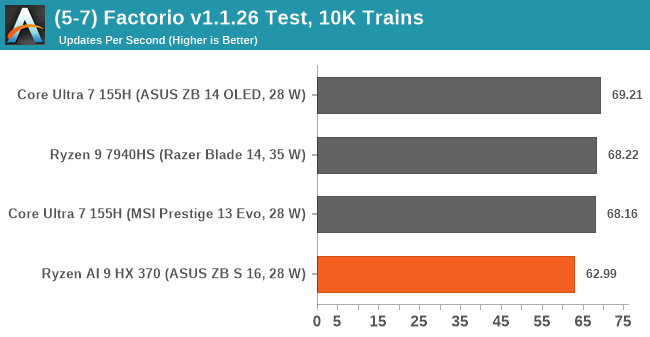
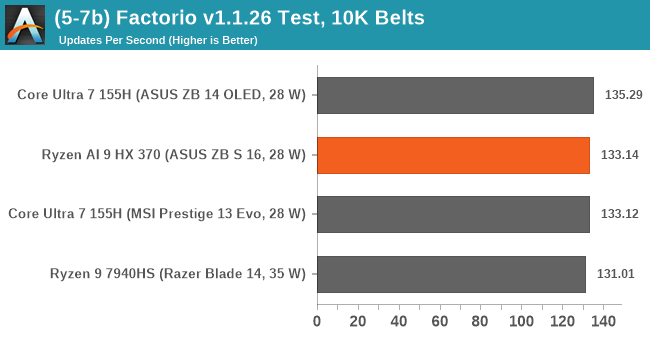
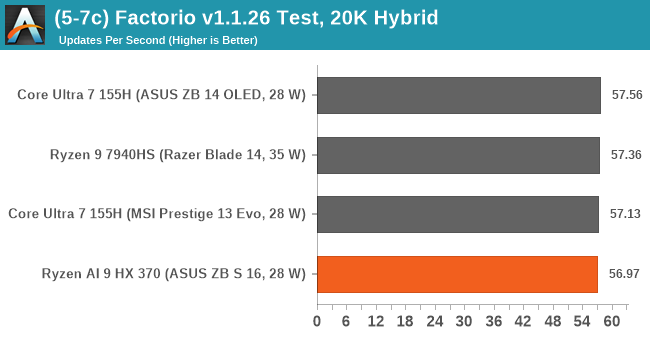
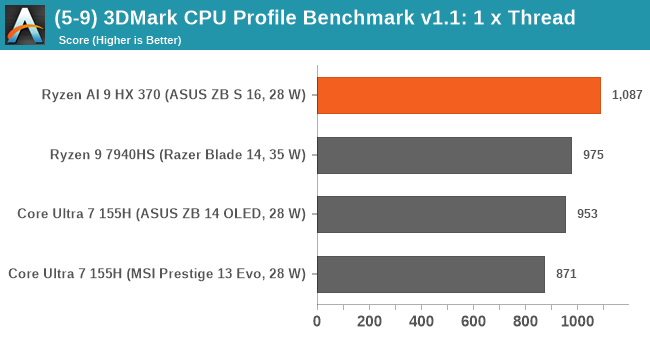
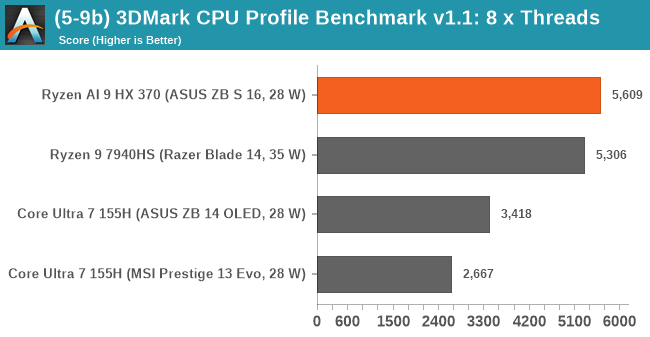
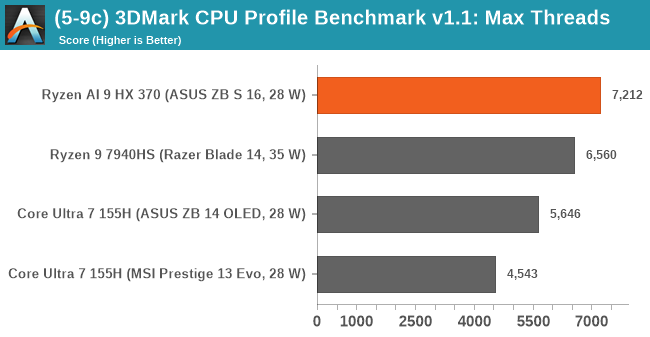
Despite winning the battle in rendering performance, we see the tables turn in both our gaming simulations, which consist of Dwarf Fortress and Factorio. In this scenario, Intel takes the lead, although, in the 3D Mark CPU Benchmark, the Ryzen AI 9 HX 370 comes out on top with 1 x thread, 8 x threads, and the maximum number of threads available from the chip.
AI Performance
As technology progresses at a breakneck pace, so do the demands of modern applications and workloads. As artificial intelligence (AI) and machine learning (ML) become increasingly intertwined with our daily computational tasks, it's paramount that our reviews evolve in tandem. To this end, we have AI and inferencing benchmarks in our CPU test suite for 2024.
Traditionally, CPU benchmarks have focused on various tasks, from arithmetic calculations to multimedia processing. However, with AI algorithms now driving features within some applications, from voice recognition to real-time data analysis, it's crucial to understand how modern processors handle these specific workloads. This is where our newly incorporated benchmarks come into play.
Given makers such as AMD with Ryzen AI, with multiple iterations including the XDNA 2 NPU within the Ryzen AI 9 HX 370, and Intel with their Meteor Lake mobile platform featuring AI-driven hardware, aptly named Intel AI Boost within the silicon, AI, and inferencing benchmarks will be a mainstay in our test suite as we go further into 2024 and beyond. While there's currently no defacto benchmark for AI at the moment, we've compiled a couple of different benchmarks to gauge performance.
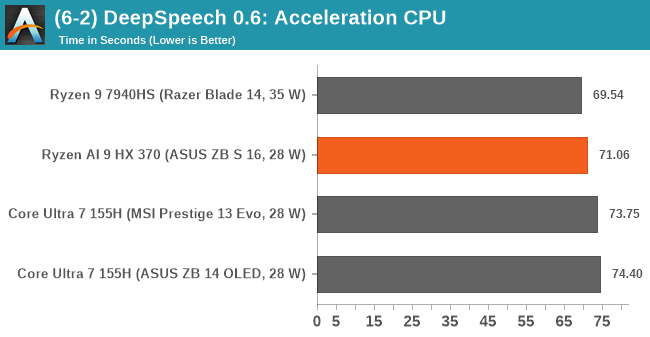
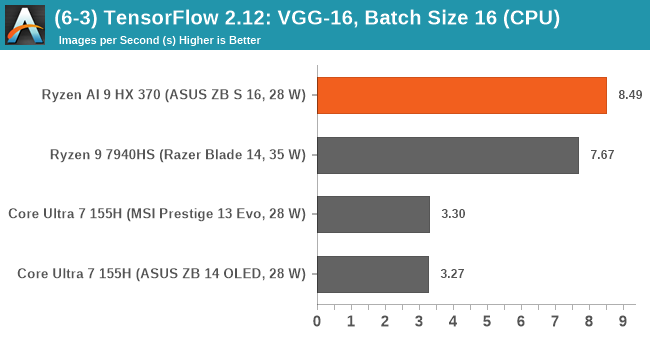
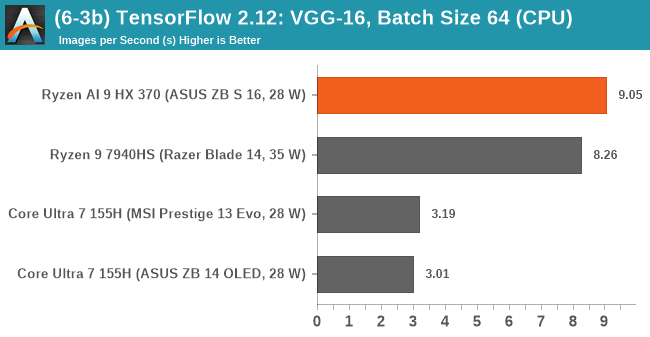
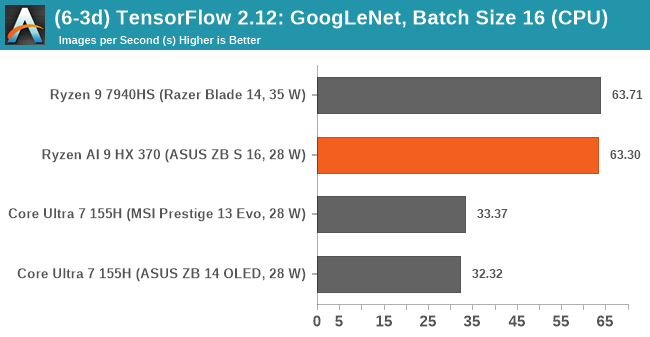
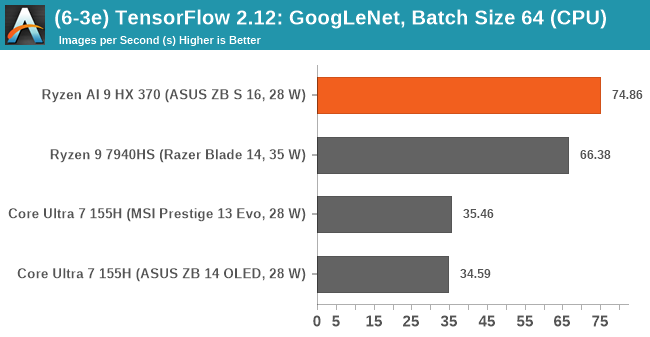
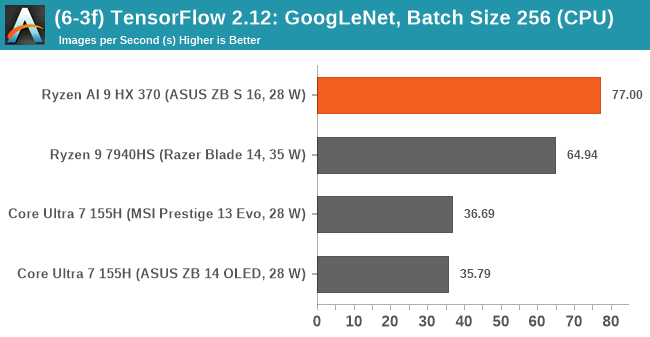
As we've said, benchmarking AI is currently something of an oxymoron, as AI models and LLMs are constantly evolving and changing at a rapid pace. There isn't a defined benchmark that tests AI performance from a level playing field, and we're seeing different models being optimized differently on architectures. The other thing is AMD, Intel, and Qualcomm are all implementing their own Neural Processing Units (NPUs) into the silicon, which in part is being driven by Microsoft and their requirement for NPUs to be above 40 TOPS for their Copilot+ PCs.
Our AI model-focused benchmarks show the Ryzen 9 7940HS at the top, marginally over the competition in our DeepSpeech acceleration test. At the same time, AMD takes advantage of our TensorFlow 2.12 tests when using the VGG-16 neural net. When switching to GoogLeNet, we actually see the Ryzen AI 9 HX 370 and the Ryzen 9 7940HS trading blows, with Intel trailing in their wake. This is what we mean about measuring AI performance, as Intel, when using OpenVino, is designed to have an advantage.
Currently, we are trying to come up with a way of testing AI performance, especially on hardware with dedicated NPUs, which is on somewhat of a more level playing field. Even the AI benchmarks within the UL Procyon suite aren't a good indicator of where each manufacturer's NPUs are at. Although the Intel-based NPUs are supported, AMD's currently aren't within the test suite, which, again, makes it difficult to find a fair battle to trade blows at.
Graphics Performance
Moving on to gaming performance, AMD has upgraded their integrated graphics within Strix Point to the RDNA 3.5 architecture. RDNA 3.5 improves things over RDNA 3 within Phoenix and Hawk Point in multiple areas. One thing RDNA 3.5 does is greatly increase the GPU's capacity to execute complicated graphics operations more effectively by optimizing key things such as texture sampling and interpolation. Upgrading the memory management in RDNA 3.5 also allows for better overall power optimization and data handling to address major GPU performance issues.
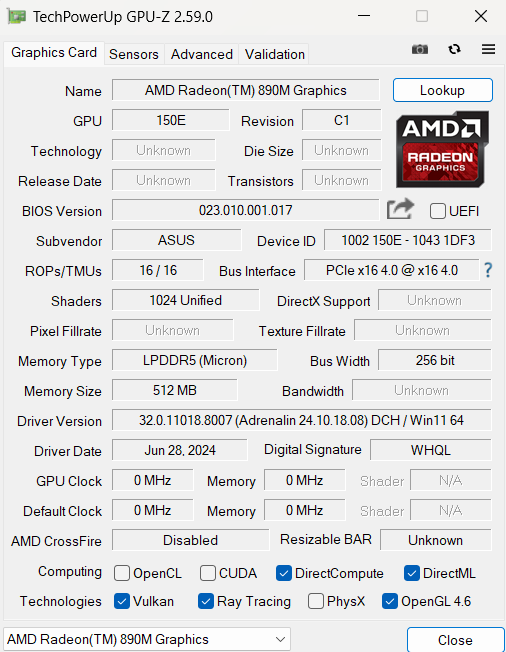
Screenshot of the AMD Ryzen AI 9 HX 370 with Radeon 890M in GPU-Z
All of the improvements and upgrades over RDNA 3 should theoretically translate into better real-world gaming performance. Generally, any form of mobile SoC doesn't quite bring the power or graphics compute to the same level as discrete graphics, which have more die area to play with, a higher transistor budget at the manufacturing level, and more power.
As the new AMD Radeon 890M graphics is the direct successor to the Radeon 780M, it does have an obvious competitor in the previous Phoenix and Hawk Point mobile SoCs. Until Intel launches its upcoming Lunar Lake mobile SoC, the other competitor is Intel's current Meteor Lake-based Arc Xe LPG integrated graphics. Another contender is AMD's own RDNA 3.5 sibling to the Radeon 890M in the Ryzen AI 9 HX pairing, which is the Radeon 880M and is found in the Ryzen AI 9 365. The main difference between the Radeon 890M and the 880M is in the number of graphic cores or compute units (CUs). The Radeon 890M features 16 x CUs, while the Radeon 880M comes with 12 x CUs.
As integrated graphics get their memory from the primary pool of DRAM installed, slower system memory can be hindered by bandwidth. AMD's Ryzen AI 300 series allows for both DDR5-5600 and LPDDR5x-7500, which is what the ASUS Zenbook S 16 we're testing uses.
For this review, we will focus on gaming performance at 1080p, which is the most commonly used gaming resolution according to the latest Steam survey. Given that these are mobile chips, we've opted for middle-of-the-road settings using the Medium preset. Despite the advancements in integrated graphics, they still lack the horsepower of discrete graphics.
Gaming Performance @ 1080p Medium Settings
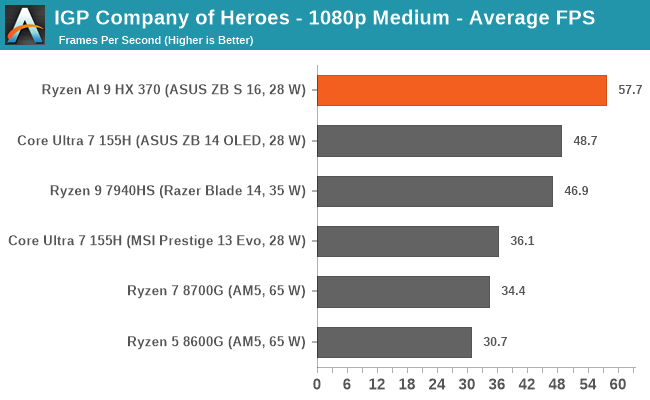
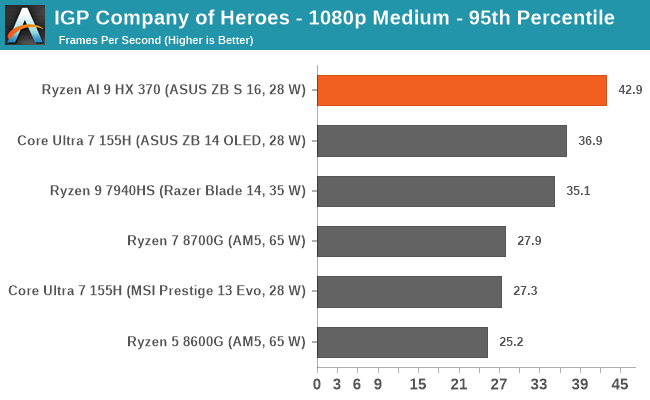
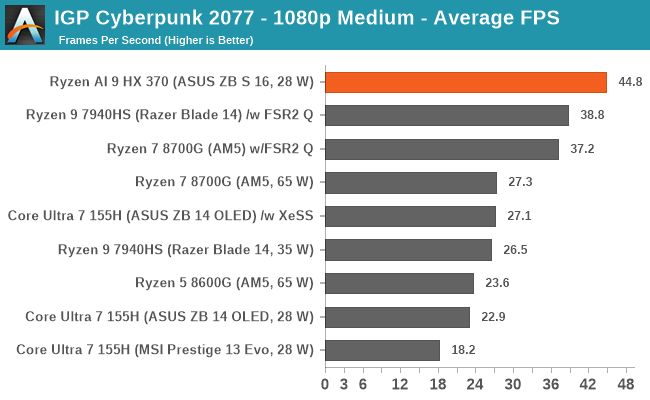
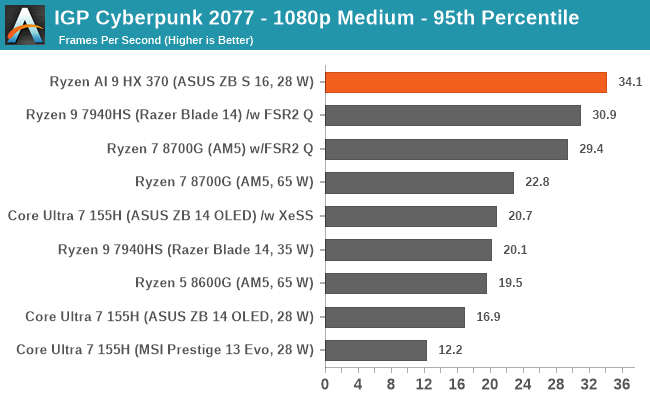
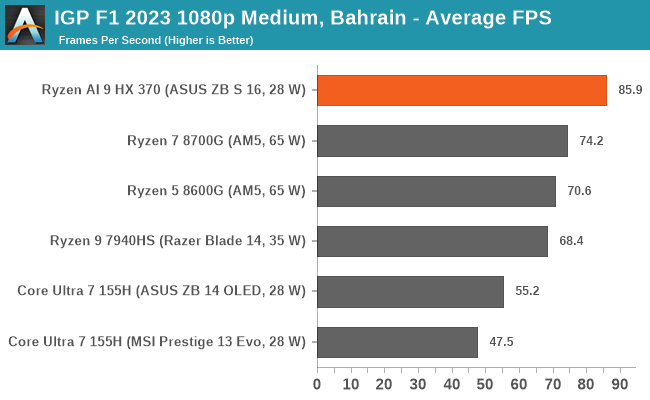
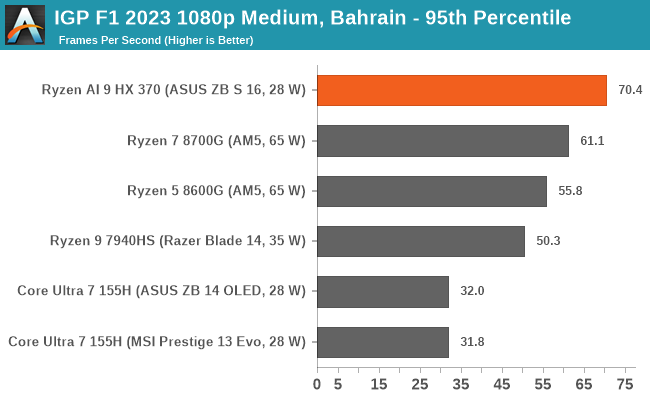
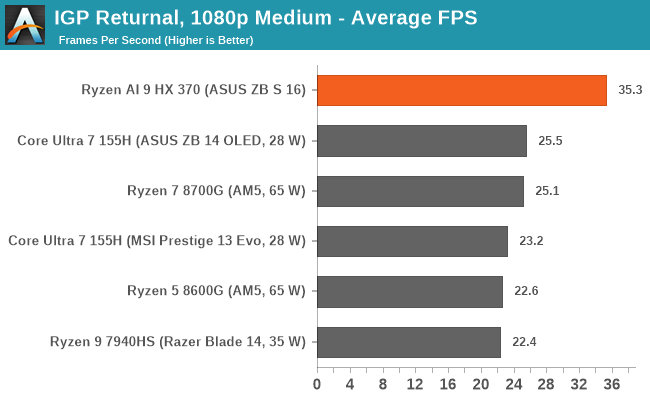
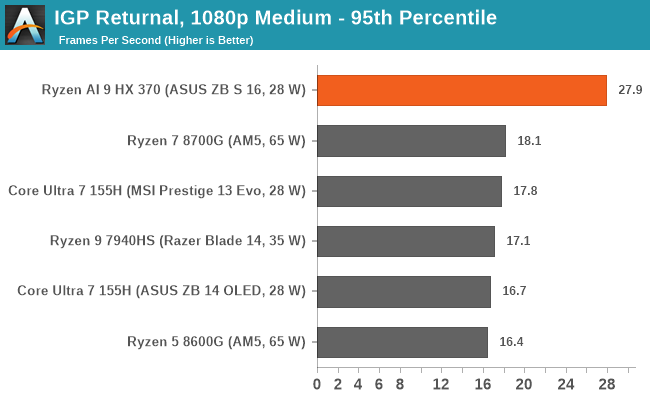
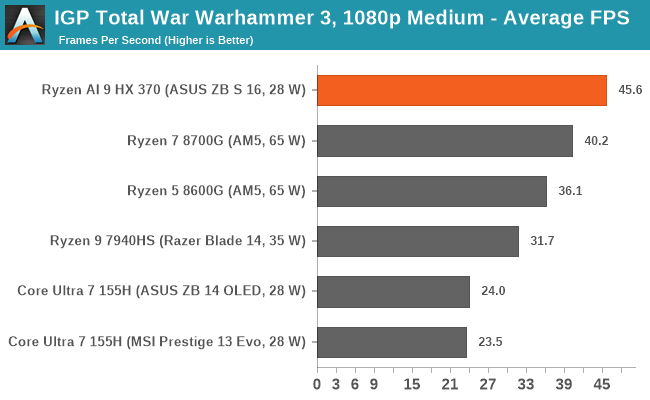
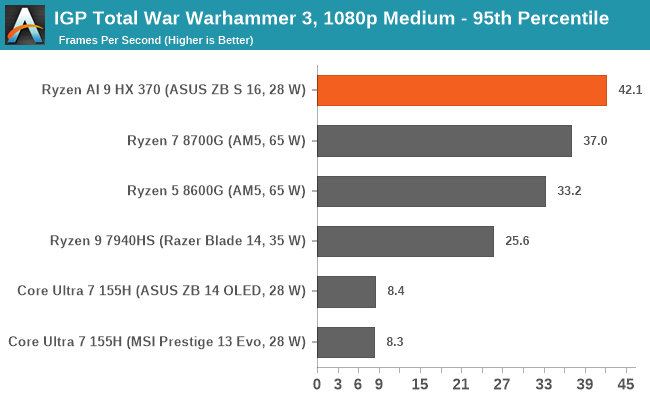
Looking at the performance of the Radeon 890M within the Ryzen AI 9 HX 370, we can see that the combination of Zen 5/Zen 5c cores and the latest RDNA 3.5 graphics performs consistently well at 1080p. Given the Ryzen AI 9 HX 370 has a higher core count with 12C/24T (4 x Z5 + 8 x Z5c) compared to the Ryzen 9 7940HS (8C/16T), the latest Soc also has a higher number of graphics compute units (16 CUs vs. 12 CUs). On top of that, you also have to factor in the jump in CPU architecture to Zen 5 over Zen 4; the latest SoC certainly does have an advantage.
In Company of Heroes 3 at medium settings, this game can simultaneously be very taxing on the CPU cores and graphics. The Ryzen AI 9 HX 370 with the Radeon 890M graphics is around 23% faster than the Ryzen 9 7940HS/Radeon 780M, although to make things a level playing field, we are testing the 7940HS at 35 W.
We also see good gains over the Ryzen 9 7940HS and Intel's Core Ultra 7 155H, which is a 6P+8E/22T chip with their Arc Xe integrated graphics that has 8 x CUs in Cyberpunk 2022 and F1 2023, but we are also seeing an uptick of 38% compared to the Core Ultra 7 155H in Returnal; for contrast, it beats the Ryzen 7940HS by around 57%.
Overall, AMD's latest RDNA 3.5 graphics architecture and the Zen 5 pairing certainly improve integrated graphics performance. This is a good thing, although integrated graphics are still not quite there when it comes to achieving a consistent 1080p/60fps in demanding titles. Games such as MOBAs, including League of Legends and DOTA 2, and other less demanding games will certainly play well on this iGPU.
Conclusion
This year is perhaps one of the busiest of this decade for the PC, both in terms of the competitive landscape and how each chip manufacturer is trying to stay ahead of the other. If you've been keeping your ear close to the ground, looking to hear about what's coming around the corner or even what's going to be the next big thing (yes, RGB, you've had your day), then the most commonly used phrase when mentioned alongside the PC is AI. It's not just a buzzword, but it's an entire market driver with a lot of weight being pushed behind it from all sides.
Regardless of the opinion on AI, the AI PC, or what the AI PC actually is, more and more consumer hardware is coming equipped with AI on the chip. The first to market in the consumer space with a dedicated AI engine in the notebook space was AMD with their Zen 4-based Phoenix Point or the Ryzen 7040 series. Not to be outdone, but both Intel and even Quallcom have mobile processors with a Neural Processing Unit, or NPU as they are commonly known. It's less of a race to get AI on the PC, but it's more about who has the biggest TOPS.
Touching on who currently has the biggest and meanest NPU on-chip in the notebook market with the highest TOPS is AMD, with the new XDNA 2 NPU architecture bringing this (current) victory to team AMD with the launch of the Ryzen AI 300 series, codenamed Strix Point. The Ryzen AI 300 series not only brings the highest TOPS from an NPU out, but it also marks the launch of AMD's latest Zen 5 microarchitecture. Even further, AMD has also brought their compact Zen 5c cores out on the same day as the main architecture, which is something they haven't done before; the compact cores usually come much later in the release cycle.
Today, AMD launches their Ryzen AI 300 series SoCs to the world, with a mixture of full-fat Zen 5 cores and the compact Zen 5c cores on the same die; they are, however, on their own CCXs. There are three chips at present, with the third being a late announcement, the Ryzen AI 9 HX 375, which actually has an XDNA 2 NPU, which is claimed to have 55 TOPS of AI performance under its hood. However, the rest of it is the same as the SoC we've been reviewing today, courtesy of the new ASUS Zenbook S 16 UM5606, which uses the AMD Ryzen AI 9 HX 370 to drive both compute and graphics.
The AMD Ryzen AI 9 HX 370 not only marks a new nomenclature, it not only brings the highest level of TOPS to notebooks on the market, but it also brings with it a new CPU core, Zen 5, which is built on TSMC's N4P (4 nm) node, but it also brings friends to the party. On top of the new XDNA 2 NPU, which is much faster than the previous NPU found in Phoenix and Hawk Point, it also brings the RDNA 3.5 graphics architecture, which looks to bring a whole host of improvements over RDNA 3 in terms of gaming performance.
Coming with a 12C/24T design, which consists of 4 x Zen 5 (full size) cores alongside 8 x Zen 5c (compact) cores, it has a base frequency of just 2.0 GHz, but the full-fat Zen 5 cores can boost all the way up to 5.1 GHz. Although it has a variable TDP of between 15 and 54 W, inside of the Zenbook S 16, it's configured at AMD's default TDP, which is 28 W. This puts it on parallel power-wise with Intel's Meteor Lake SoC chips. In contrast, the Ryzen 8040HS series had chips that started at 35 W and could be configured up to 54 W depending on the caliber of notebook or laptop it came in. However, TDPs aside, Zen 5 has finally arrived, and it's time to analyze how it currently shapes up in the mobile space.
Ryzen AI 9 HX 370 Performance Analysis
In this review, we not only tested the AMD Ryzen AI 9 HX 370 SoC (12C/24T) with the new Radeon 890M integrated graphics, but we've put it up against what it's replacing in the Zen 4 based Ryzen 9 7940HS (8C/16T) which has the RDNA 3 based Radeon 780M graphics. Intel's current Meteor Lake SoC, with the Intel Core Ultra 7 155H showcased in two notebooks, is also included.

First up, the Ryzen AI 9 HX 370 didn't really appear to be anything special in the office and encoding sections of our CPU suite, with middling performance competitive with everything else. It put everything else to bed, though, and allowed the new Zen 5 cores (and Zen 5c) to stretch their proverbial legs. In the Cinebench 2024 rendering benchmark with the multi-threaded test selected, we saw the Ryzen AI 9 HX 370 outperform the Zen 4-based Ryzen 9 7940HS by around 17%, which is certainly a good win for Zen 5. It does have more cores, albeit more efficient and compact Zen 5c cores, but winning is winning.

While Zen 5 boasts large IPC gains over Zen 4 (AMD claimed 16% on average), we didn't really see this for ourselves. The Ryzen AI 9 HX 370 still outperformed the 7940HS in the Cinebench 2024 single-threaded test, but it was more like 7% and not the 16% everyone was excited about. Fire up a workload that utilizes AVX-512, and sure, it will demolish, but in typical tasks, not so much.
AMD RDNA 3.5 Delivers Better Gaming Performance Than 3.0
Comparing RDNA 3 (Radeon 780M) to the latest RDNA 3.5 (Radeon 890M) in the Ryzen AI 9 HX 370, we saw improvements across all of our suites, which shows AMD has done wonders to improve their integrated graphics.

A prime example of AMD making improvements in performance over the last generation with the new Zen 5/Zen 5c SoC is in Returnal at 1080p with the medium preset selected. It managed to outperform the Ryzen 9 7940HS by 57%. While this isn't going to be the case in every game, we did see a consistent advantage to the Ryzen AI 9 HX 370 over the previous Phoenix Point-based 7940HS.
Overall, the combination of Zen 5 cores coupled with the RDNA 3.5-based Radeon 890M delivers better performance in gaming than the Phoenix-based Zen 4 predecessor and it also keeps Intel's current Meteor Lake SoC at bay. Still, it has to be said that integrated graphics still aren't quite there when it comes to delivering 1080p/60fps gaming, especially in big titles or AAA games, as they are more widely known. In lesser intensive games such as League of Legends, DOTA 2, and Faster Than Light.
The ASUS Zenbook S 16 UM5606: Sleek, Elegant and Highly Relevant
It wouldn't be fair to wrap up the Ryzen AI 9 HX 370 review without first giving some feedback and attention to ASUS's new Zenbook S 16 ultraportable notebook. The first thing to touch on is the design and overall composition of the Zenbook S 16's look and feel. First of all, the color is called 'Scandinavian White,' but to me, it looks more like a matte light silver, which isn't a complaint from me because it looks really good, especially when the sun shines on it. Secondly, it certainly looks lighter than it appears to be, but it's still lighter than the Apple 16-inch MacBook Pro with the M3 Max and most 16-inch notebooks, to be honest. It's deceptive how stylish and cloud-like it looks, but that's just my perception of how much it weighs compared to how I thought it was going to weigh based on how it looks.
Moving on, of course, the AMD Ryzen AI 9 HX 370 is going to take much of the plaudits, but the Zenbook 16 S certainly deserves some plaudits, too. It's thin at just 11.9 mm thick and includes plenty of nice subtle features, including thin bezels around the 16-inch Lumina OLED touchscreen display and an elegant white backlit keyboard that looks good when the lights get dimmed.
Of course, not everything is about looks, and at the heart of everything making it beat is the AMD Ryzen AI 9 HX 370. The ASUS Zenbook S 16 UM5606 itself, though, looks and feels as premium as any high-end notebook; it's packed with AI-integrated software features and applications for users to dive into if that's their thing. The chassis is made from ASUS's own material called 'Ceraluminum.' ASUS describes it as a high-tech ceramic designed to be both robust and light, with the naming sort of implying that it combines ceramic and aluminum. The result is a simple yet striking design that feels every bit as premium as it looks.
The ASUS Zenbook S 16 UM5606 starts at $1699 and is available now at retailers and on ASUS's website.
Final Thoughts: Ryzen AI 9 HX 370 Delivers in Intensive Loads, and RDNA 3.5 Does Well
AMD has firmly positioned itself at the forefront of the notebook market with the launch of the Ryzen AI 300 series, with Zen 5 being the star of the show. Zen 5 is the latest microarchitecture in AMD's roadmap and brings a host of improved architectures on key parts of the die itself. This includes the XDNA 2 NPU, which looks set to drive Microsoft Copilot+ AI-driven software into action and potentially push what NPUs and AI on-chip can do even more as we head into 2025.
AMD also has the updated and upgraded RDNA 3.5 integrated graphics to help drive things forward, but again, it still doesn't compete with discrete graphics in terms of gaming performance. In contrast, it's designed more for premium ultrathin notebooks such as the ASUS Zenbook S 16, which seems a fitting launch platform for it.
Although the Ryzen AI 9 HX 370 with four regular Zen 5 cores and eight compact Zen 5c cores performed pretty well in multiple areas, it certainly did it when it counted, especially in more intensive workloads such as rendering. Less intensive workloads didn't really didn't tax it too much, and in those cases, it was pretty average in all honesty. In regular and real-world scenarios and workloads, we certainly didn't see up to a 16% increase in IPC performance, but the key is that Zen 5 has improved IPC over Zen 4.
The Ryzen AI 300 series, including the Ryzen AI 9 HX 370, looks set to ignite a 'battle of the TOPS' where Generative AI performance is concerned among the main chip makers. Still, now that we've got Zen 5 in mobile, it'll be time soon to pivot towards Zen 5 for desktop, with the launch of the Ryzen 9000 series coming fast. In fact, it's in less than two weeks ever since AMD delayed the launch, so it'll be interesting to see how Zen 5 compares to Zen 4 on the desktop, which is certainly a much hotter battleground.

